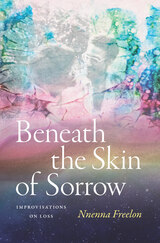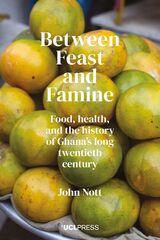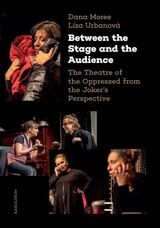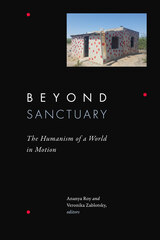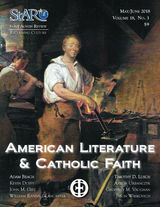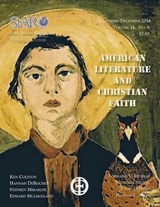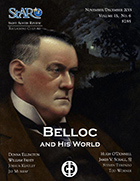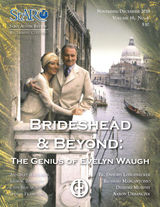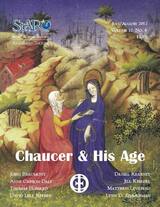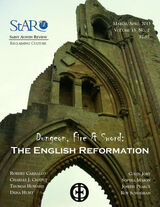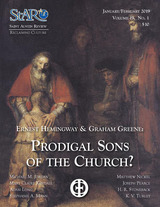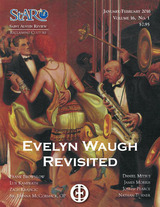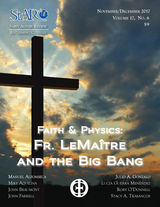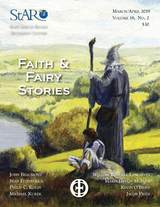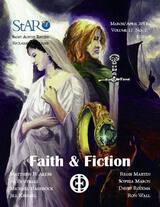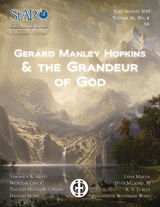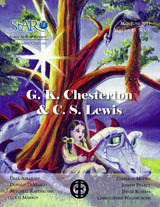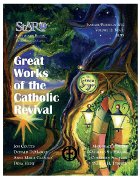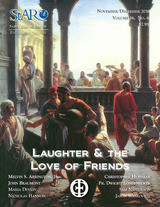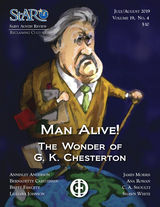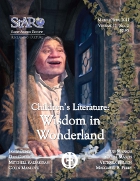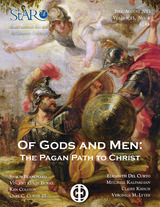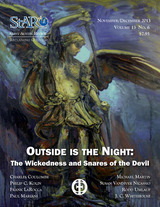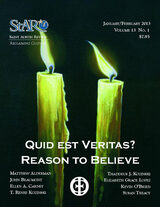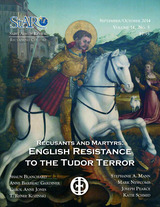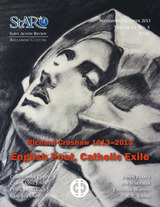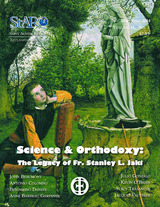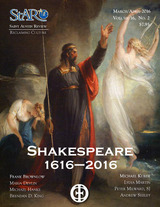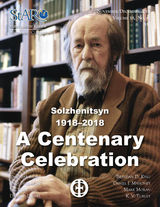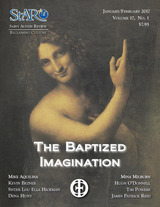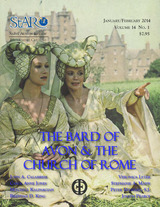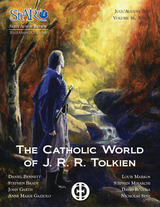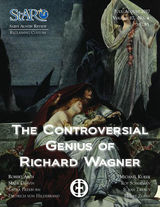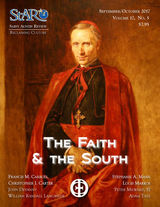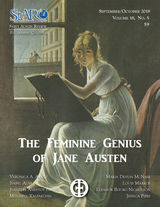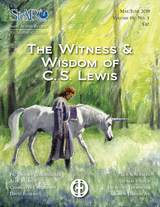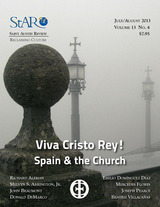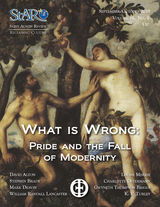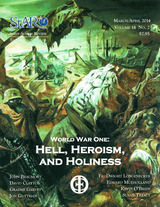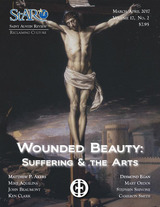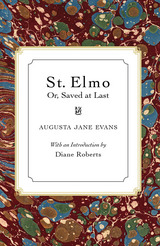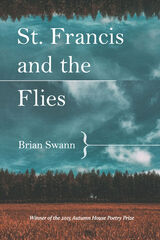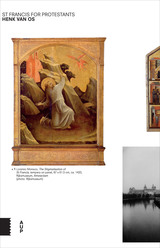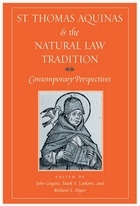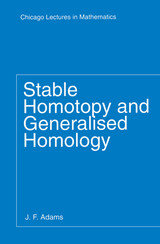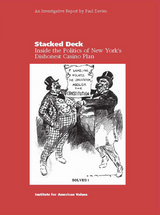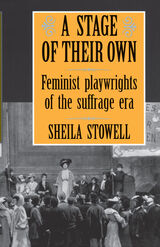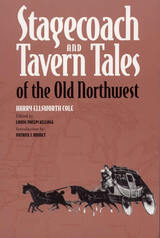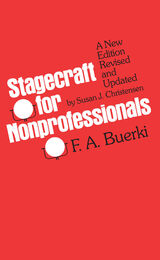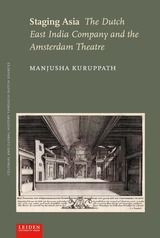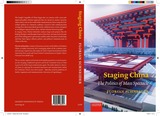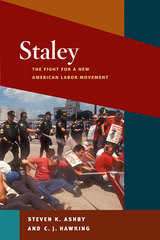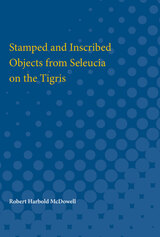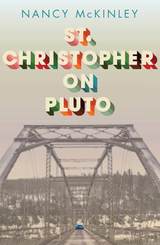 St. Christopher on Pluto
Nancy McKinley
West Virginia University Press, 2020 *2021 Colorado Book Awards Finalist, Literary Fiction*
MK and Colleen get reacquainted while working at different stores in a bankrupt mall. Way back, the women went to Catholic school together and collaborated on racy letters to a soldier in Vietnam who thought they were much older than seventh graders—a ruse that typifies later shenanigans, usually brought on by red-headed Colleen, a self-proclaimed “Celtic warrior.” After ditching Colleen’s car to collect the insurance, they drive from one unexpected event to the next in Big Blue, MK’s Buick clunker with a St. Christopher statue glued to the dash. The glow-in-the-dark icon guides them past the farm debris, mine ruins, and fracking waste of the northern brow of Appalachia. Yet their world is not a dystopia. Rather, MK and Colleen show why, amid all the desperation, there is still a community of hope, filled with people looking out for their neighbors and with survivors who offer joy, laughter, and good will.
St. Elisabeth of Thuringia: A Psychological Study (1931)
Elisabeth Busse-Wilson
Amsterdam University Press, 2025 Only twelve years after German women had been granted voting rights, the German medievalist Elisabeth Busse-Wilson, a first-wave feminist activist and scholar, challenged centuries of silence about violence against women by taking on the case of the most famous European saint, the young Elisabeth of Thuringia (1207–1231). Married at a very young age, St. Elisabeth soon fell under the spell of the notorious confessor and inquisitor Konrad von Marburg. His brutal treatment of the young woman was erased from the cult of St. Elisabeth to protect male privilege both in the church and society at large.
Published to coincide with the 700-year anniversary of her death, Busse-Wilson’s study caused a storm of controversy. Translated for the first time into English, this book reintroduces to a contemporary audience this long-forgotten but still provocative and timely classic.
St. Elmo: Or, Saved at Last
Augusta Jane Evans
University of Alabama Press, 1992 St. Elmo was the most famed and beloved novel by Augusta Jane Evans, a June 2015 inductee into the Alabama Writers Hall of Fame. First published in 1866, Evans’s rich tale of the relationship between the dashing and worldly St. Elmo and Edna Earl, an exemplar of virtuous Southern womanhood, sold over a million copies in four months and became one of the nineteenth century’s most influential novels.
This edition includes an introduction by Evans scholar Diane Roberts about the enduring relevance and legacy of St. Elmo as a work of literature as well as a reflection of gender roles and the seismic societal changes taking place in the United States in the aftermath of the Civil War.
St. Francis and the Flies
Brian Swann
Autumn House Press, 2016 Winner of the 2015 Autumn House Press Poetry Contest, selected by Dorianne Laux. St. Francis and the Flies is the 11th poetry collection of noted translator, Brian Swann. These stunning poems engage with the natural world unlike any other poet of our time. Rich with history, Swann's poem are both complex and delicate.
St Francis for Protestants
Henk van Os
Amsterdam University Press, 2017 Lorenzo Monaco's striking fifteenth-century portrayal of the stigmatisation of St. Francis was once owned by the art collector Otto Lanz. What prompted Lanz to buy Monaco's painting in the 1920s? Was it simply because he saw it as a beautiful, unique work of art? Or was there something more—could Lanz have been drawn in by the mystical experience that the painting depicts? In this essay, Henk van Os attempts to uncover the motivation for Otto Lanz’s purchase, in the process raising provocative questions about our relationship to religious art in a more secular era.
 St. Jerome's Commentaries on Galatians, Titus, and Philemon
Thomas P. Scheck
University of Notre Dame Press, 2010
St. Jerome (347-420) was undoubtedly one of the most learned of the Latin Church Fathers. He mastered nearly the entirety of the antecedent Christian exegetical and theological tradition, both Greek and Latin, and he knew Hebrew and Aramaic. We have the fruit of that knowledge in his most famous editorial achievement, the Latin Vulgate translation of the Bible. Declared "the greatest doctor in explaining the Scriptures" by the Council of Trent, Jerome has been regarded by the Latin Church as its preeminent scriptural commentator.
Much of Jerome's prodigious exegetical output, however, has never been translated into English. In this volume, Thomas P. Scheck presents the first English translation of St. Jerome's commentaries on Galatians, Titus, and Philemon. Jerome followed the Greek exegesis of Origen of Alexandria, proceeding step by step and producing the most valuable of all of the patristic commentaries on these three epistles of St. Paul. Jerome's exegesis is characterized by extensive learning, acute historical and theological criticism, lively and vigorous exposition, and homiletical exhortation.
Scheck's translation is supplemented with thorough annotations and a detailed critical introduction that sets the context for reading Jerome's commentaries. It is an invaluable reference for patristics scholars, historical theologians, Church historians, and New Testament scholars.
"Scheck's introduction is clearly written and lucid, containing fine theological observations as well as a clear historical context for Jerome's commentary. Scheck's excellent translation comes at a most opportune time given that interest in patristic exegesis is high and Jerome is among the best of the ancient commentators on Galatians." --Joseph T. Lienhard, S.J., Fordham University
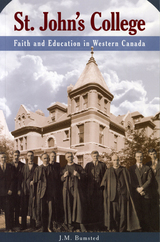 St. John's College: Faith and Education in Western Canada
J.M. Bumsted
University of Manitoba Press, 2006 Winnipeg’s St. John’s College is one of the oldest educational institutions in western Canada. Its roots go back to the Red River Settlement in the 1850s when it first began as a school for the English-speaking children of the employees of the Hudson’s Bay Company. By the 1880s, the college had developed into an Anglican institution providing instruction in the liberal arts and theology, and in the same period it became one of the founding colleges of the University of Manitoba. By the 1920s, it was responsible for producing some of the university’s finest students, including the historian W.L. Morton. For much of its 150-year history, St. John’s was closely connected with Manitoba’s Anglo-Celtic financial and political elite, and it often shared both the strengths and shortcomings of that group. Following the college through its many permutations, J.M. Bumsted provides a fascinating history of the birth and growth of post-secondary education in western Canada.
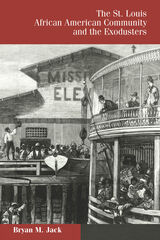 The St. Louis African American Community and the Exodusters
Bryan M. Jack
University of Missouri Press, 2021 In the aftermath of the Civil War, thousands of former slaves made their way from the South to the Kansas plains. Called “Exodusters,” they were searching for their own promised land. Bryan Jack now tells the story of this American exodus as it played out in St. Louis, a key stop in the journey west. Many of the Exodusters landed on the St. Louis levee destitute, appearing more as refugees than as homesteaders, and city officials refused aid for fear of encouraging more migrants. To the stranded Exodusters, St. Louis became a barrier as formidable as the Red Sea, and Jack tells how the city’s African American community organized relief in response to this crisis and provided the migrants with funds to continue their journey. The St. Louis African American Community and the Exodusters tells of former slaves such as George Rogers and Jacob Stevens, who fled violence and intimidation in Louisiana and Mississippi. It documents the efforts of individuals in St. Louis, such as Charlton Tandy, Moses Dickson, and Rev. John Turner, who reached out to help them. But it also shows that black aid to the Exodusters was more than charity. Jack argues that community support was a form of collective resistance to white supremacy and segregation as well as a statement for freedom and self-direction—reflecting an understanding that if the Exodusters’ right to freedom of movement was limited, so would be the rights of all African Americans. He also discusses divisions within the African American community and among its leaders regarding the nature of aid and even whether it should be provided. In telling of the community’s efforts—a commitment to civil rights that had started well before the Civil War—Jack provides a more complete picture of St. Louis as a city, of Missouri as a state, and of African American life in an era of dramatic change. Blending African American, southern, western, and labor history, The St. Louis African American Community and the Exodusters offers an important new lens for exploring the complex racial relationships that existed within post-Reconstruction America.
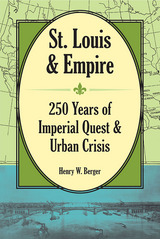 St. Louis and Empire: 250 Years of Imperial Quest and Urban Crisis
Henry W. Berger
Southern Illinois University Press, 2015 At first glance, St. Louis, Missouri, or any American city, for that matter, seems to have little to do with foreign relations, a field ostensibly conducted on a nation-state level. However, St. Louis, despite its status as an inland river city frequently relegated to the backwaters of national significance, has stood at the crossroads of international matters for much of its history. From its eighteenth-century French fur trade origins to post–Cold War business dealings with Latin America and Asia, the city has never neglected nor been ignored by the world outside its borders. In this pioneering study, Henry W. Berger analyzes St. Louis’s imperial engagement from its founding in 1764 to the present day, revealing the intersection of local political, cultural, and economic interests in foreign affairs.
Berger uses a biographical approach to explore the individuals and institutions that played a leading role in St. Louis’s expansionist reach. He shows how St. Louis business leaders, entrepreneurs, politicians, and investors—often driven by personal and ideological motives, as well as the potential betterment of the city and its people—looked to the west, southwest, Latin America, Europe, Asia, and the Pacific to form economic or political partnerships. Among the people and companies Berger profiles are Thomas Hart Benton, who envisioned a western democratic capitalist empire hosted by St. Louis; cotton exporters James Paramore and William Senter, who were involved in empire building in the southwest and Mexico; St. Louis oil tycoon and railroad investor Henry Clay Pierce, who became deeply involved in political intrigue and intervention in Mexican affairs; entrepreneur and politician David R. Francis, who promoted personal and St. Louis interests in Russia; and McDonnell-Douglas and its founder, James S. McDonnell Jr., who were part of the transformation of St. Louis’s political economy during the Cold War.
Many of these attempted imperial activities failed, but even when they succeeded, Berger explains, the economy and the people of St. Louis did not usually benefit. The vision of a democratic capitalist empire embraced by its exponents proved to be both an illusion and a contradiction. By shifting the focus of foreign relations history from the traditional confines of nation-state conduct to city and regional behavior, this innovative study highlights the domestic foundations and content of foreign policy, opening new avenues for study in the field of foreign relations.
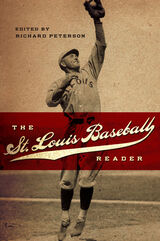 The St. Louis Baseball Reader
Richard Peterson
University of Missouri Press, 2022 The St. Louis Baseball Reader is a tale of two teams: one the city’s lovable losers, the other a formidable dynasty. The St. Louis Cardinals are the most successful franchise in National League history, while the St. Louis Browns were one of the least successful, yet most colorful, American League teams. Now Richard Peterson has collected the writings of some of baseball’s greatest storytellers to pay tribute to both these teams. His book, the first anthology devoted exclusively to the Cardinals and Browns, covers the rich history of St. Louis baseball from its late-nineteenth-century origins to the modern era. The St. Louis Baseball Reader is a celebration of the many legendary stars and colorful characters who wore St. Louis uniforms and the writers who told their stories, including Alfred Spink, Roger Angell, George Will, and Baseball Hall of Fame writers Bob Broeg, J. Roy Stockton, Red Smith, and Fred Lieb. Here, too, are John Grisham, who grew up a Redbirds fan in Mississippi, and Jack Buck, the most identifiable voice in Cardinal history. Great players—Grover Cleveland Alexander, Rogers Hornsby, Marty Marion, and Satchel Paige—tell their own stories, while Bill Veeck offers an account of his wild ride as the last Browns owner and Whitey Herzog shares regrets about the play that cost the Cardinals the 1985 World Series. From the days of the Gas House Gang to the 1944 “Streetcar Series,” from Bill Veeck’s legendary stunts to Mark McGwire’s pursuit of Roger Maris’s home-run record, the Reader will bring back memories for every fan. It takes in all of the magic of the ballpark—whether recounting the unhittable pitching of Bob Gibson, the slugging prowess of Stan “The Man” Musial, or the sterling glove-work of Ozzie Smith—along with reflective commentaries that tell how Jackie Robinson confronted racism and Curt Flood challenged the reserve clause. St. Louis is a city blessed with a memorable baseball history, and The St. Louis Baseball Reader perfectly captures the joy and heartbreak of its winning and losing teams. It’s a book that will delight current fans of the Cardinals and old-timers who fondly recall the Browns.
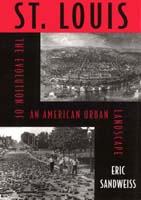 St. Louis: Evolution Of American Urban Landscape
ERIC SANDWEISS
Temple University Press, 2001 St. Louis's story stands for the story of all those cities whose ambitions and civic self-image, forged from the growth of the mercantile and industrial eras, have been dramatically altered over time. More dramatically, perhaps, than most -- but in a manner shared by all -- St. Louis's changing economic base, shifting population and altered landscape have forced scholars, policymakers, and residents alike to acknowledge the transciency of what once seemed inexorable metropolitan trends: concentration, growth, accumulated wealth, and generally improved well-being.
In this book, Eric Sandweiss scrutinizes the everyday landscape -- streets, houses, neighborhoods, and public buildings -- as it evolved in a classic American city. Bringing to life the spaces that most of us pass without noticing, he reveals how the processes of dividing, trading, improving, and dwelling upon land are acts that reflect and shape social relations. From its origins as a French colonial settlement in the eighteenth century to the present day, St. Louis offers a story not just about how our past is diagrammed in brick and asphalt, but also about the American city's continuing viability as a place where the balance of individual rights and collective responsibilities can be debated, demonstrated and adjusted for generations to come.
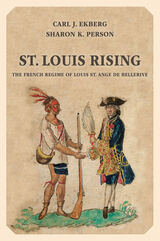 St. Louis Rising: The French Regime of Louis St. Ange de Bellerive
Carl J. Ekberg and Sharon K. Person
University of Illinois Press, 2015 The standard story of St. Louis's founding tells of fur traders Pierre Laclède and Auguste Chouteau hacking a city out of wilderness. St. Louis Rising overturns such gauzy myths with the contrarian thesis that French government officials and institutions shaped and structured early city society. Of the former, none did more than Louis St. Ange de Bellerive. His commitment to the Bourbon monarchy and to civil tranquility made him the prime mover as St. Louis emerged during the tumult following the French and Indian War.
Drawing on new source materials, the authors delve into the complexities of politics, Indian affairs, slavery, and material culture that defined the city's founding period. Their alternative version of the oft-told tale uncovers the imperial realities--as personified by St. Ange--that truly governed in the Illinois Country of the time, and provide a trove of new information on everything from the fur trade to the arrival of the British and Spanish after the Seven Years' War.
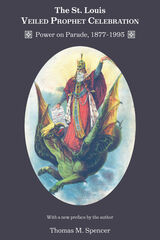 The St. Louis Veiled Prophet Celebration: Power on Parade, 1877-1995
Thomas M. Spencer
University of Missouri Press, 2021 The Veiled Prophet organization has been a vital institution in St. Louis for more than a century. Founded in March 1878 by a group of prominent St. Louis businessmen, the organization was fashioned after the New Orleans Carnival society the Mystick Krewe of Comus. In The St. Louis Veiled Prophet Celebration, Thomas Spencer explores the social and cultural functions of the organization's annual celebration—the Veiled Prophet parade and ball—and traces the shifts that occurred over the years in its cultural meaning and importance. Although scholars have researched the more pluralistic parades of the eighteenth and early nineteenth centuries, very little has been done to examine the elite-dominated parades of the late nineteenth and twentieth centuries. This study shows how pluralistic parades ceased to exist in St. Louis and why the upper echelon felt it was so important to end them. Spencer shows that the celebration originated as the business elite's response to the St. Louis general strike of 1877. Symbolically gaining control of the streets, the elites presented St. Louis history and American history by tracing the triumphs of great men—men who happened to be the Veiled Prophet members' ancestors. The parade, therefore, was intended to awe the masses toward passivity with its symbolic show of power. The members believed that they were helping to boost St. Louis economically and culturally by enticing visitors from the surrounding communities. They also felt that the parades provided the spectators with advice on morals and social issues and distracted them from less desirable behavior like drinking and carousing. From 1900 to 1965 the celebration continued to include educational and historical elements; thereafter, it began to resemble the commercialized leisure that was increasingly becoming a part of everyday life. The biggest change occurred in the period from 1965 to 1980, when the protests of civil rights groups led many St. Louisans to view the parade and ball as wasteful conspicuous consumption that was often subsidized with taxpayers' money. With membership dropping and the news media giving the organization little notice, it soon began to wither. In response, the leaders of the Veiled Prophet organization decided to have a "VP Fair" over the Fourth of July weekend. The 1990s brought even more changes, and the members began to view the celebration as a way to unite the St. Louis community, with all of its diversity, rather than as a chance to boost the city or teach cultural values. The St. Louis Veiled Prophet Celebration is a valuable addition not only to the cultural history of Missouri and St. Louis but also to recent scholarship on urban culture, city politics, and the history of public celebrations in America.
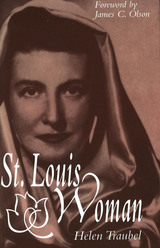 St. Louis Woman
Helen Traubel & Foreword by James C. Olson
University of Missouri Press, 1999
This charming autobiography captures the life story of a fascinating woman—a Missouri girl turned world-class soprano who remained true to her roots through it all. Born and reared in St. Louis and proud of her origins, Helen Traubel grew up in a modest German American family. She spent her teens and twenties singing with church choirs and quartets in the city, studying under first- rate teachers. She did not leave Missouri for New York until she was in her early thirties. Although she replaced the great Kirsten Flagstad at the Metropolitan Opera, she refused to confine herself to singing before elite crowds and prided herself on reaching a larger, more general audience via nightclubs, radio, television, and theater.
St. Louis Woman is filled with candid and amusing stories as full of zest as Traubel herself. In the early 1940s, she secured a rare opportunity to audition for the Ford Hour. Arriving at the studio with a terrible case of poison ivy and an understandably short temper, the diva began singing on cue as the top executives of the program listened from upstairs. During her first song, the booth technicians interrupted her performance with laughter. Furious, she announced she would sing no more and started to leave. Without explanation, the technicians asked her to continue. Traubel later discovered that the higher-ups had called down to the technicians demanding they stop playing the Flagstad record and let "that kid" sing.
The qualities that made Traubel such a notable individual are captured in this entertaining book. Her strong, independent character shines through. Outspoken and at times brutally honest, Traubel recounts her experiences at the Met, as both a popular performer and a teacher. She tells of exasperating moments when she was coaching famous pupil Margaret Truman.
This is not a fact-laden examination of the singer's Wagnerian repertory or a study of high opera; rather this engaging book introduces the reader to a nationally renowned performer who, despite her unmatched talent, retained her hometown identity and lived her life as a St. Louis woman.
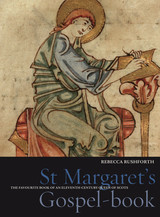 St. Margaret's Gospel: The Favourite Book of a Queen of Scotland
Rebecca Rushforth
Bodleian Library Publishing, 2007 Margaret was both a saint and a celebrated queen who, with her husband, led Scotland to great acclaim and power in eleventh-century Europe. Her favorite book was an illuminated manuscript of extracts from the gospels, and her personal copy, currently held in the Bodleian Library, is reproduced here for the pleasure of modern readers.
Margaret’s piety, dignity, and compassion made her a beloved figure long after her death. Her illuminated manuscript reveals the depths of her sanctity, opening with a Latin poem relating the one miracle attributed to her, where she preserved this book from damage. Exquisite illustrations transform the script into an arresting treasure, and Rebecca Rushforth uses incisive and comprehensive commentary to explain the story behind the manuscript and set it within Margaret’s historical context. She explores both the creation of the manuscript and its special meaning for Margaret, along with Margaret’s role as a significant figure in British and world history.
A fascinating piece of historical art, St Margaret’s Gospel-Book will be treasured by historians, religious scholars, and classicists alike.
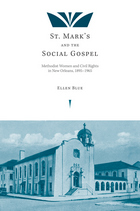 St. Mark's and the Social Gospel: Methodist Women and Civil Rights in New Orleans, 1895–1965
Ellen Blue
University of Tennessee Press, 2011
The impact of St. Mark’s Community Center and United Methodist Church on the city of New Orleans is immense. Their stories are dramatic reflections of the times. But these stories are more than mere reflections because St. Mark’s changed the picture, leading the way into different understandings of what urban diversity could and should mean. This book looks at the contributions of St. Mark’s, in particular the important role played by women (especially deaconesses) as the church confronted social issues through the rise of the social gospel movement and into the modern civil rights era.
Ellen Blue uses St. Mark’s as a microcosm to tell a larger, overlooked story about women in the Methodist Church and the sources of reform. One of the few volumes on women’s history within the church, this book challenges the dominant narrative of the social gospel movement and its past.
St. Mark’s and the Social Gospel begins by examining the period between 1895 and World War I, chronicling the center’s development from its early beginnings as a settlement house that served immigrants and documenting the early social gospel activities of Methodist women in New Orleans. Part II explores the efforts of subsequent generations of women to further gender and racial equality between the 1920s and 1960. Major topics addressed in this section include an examination of the deaconesses’ training in Christian Socialist economic theory and the church’s response to the Brown decision. The third part focuses on the church’s direct involvement in the school desegregation crisis of 1960 , including an account of the pastor who broke the white boycott of a desegregated elementary school by taking his daughter back to class there. Part IV offers a brief look at the history of St. Mark’s since 1965.
Shedding new light on an often neglected subject, St. Mark’s and the Social Gospel will be welcomed by scholars of religious history, local history, social history, and women’s studies.
 St. Patrick's Day: another day in Dublin
Thomas McGonigle
University of Notre Dame Press, 2016 On Saint Patrick's Day, an Irish American writer visiting Dublin takes a day trip around the city and muses on death, sex, lost love, Irish immigrant history, and his younger days as a student in Europe. Like James Joyce’s Ulysses, Thomas McGonigle’s award-winning novel St. Patrick’s Day takes place on a single day, combining a stream-of-consciousness narrative with masterful old-fashion storytelling, which samples the literary histories of both Ireland and America and the worlds they influence. St. Patrick’s Day relies on an interior monologue to portray the narrator’s often dark perceptions and fantasies; his memories of his family in Patchogue, New York, and of the women in his life; and his encounters throughout the day, as well as many years ago, with revelers, poets, African students, and working-class Dubliners.
Thomas McGonigle’s novel is a brilliant portrait of the uneasy alliance between the Irish and Irish Americans, the result of the centuries-old diaspora and immigration, which left unsettled the mysteries of origins and legacy. St. Patrick’s Day is a rollicking pub-crawl through multi-sexual contemporary Dublin, a novel full of passion, humor, and insight, which makes the reader the author’s accomplice, a witness to his heartfelt memorial to the fraught love affair between ancestors and generations. McGonigle tells the stories both countries need to hear. This particular St. Patrick’s Day is an unforgettable one.
"This is first rate prose. From the evidence of both this book and his previously published novel, The Corpse Dream of N. Petkov, we realize we are in the presence of a great novelist in Thomas McGonigle. He puts a certain period of Dublin literary history before our eyes with freshness and honesty. Not only that but by his skillful use of modernist techniques he gives the 'Irish Novel' a long outstanding and much deserved kick up the arse into the twenty-first century. I praise the work mightily." —Nuala Ní Dhomhnaill, Ireland Chair of Poetry and former Ireland Professor of Poetry
"A retrospective portrait of a young Irish American in Dublin, St. Patrick's Day combines the acute vision of the best fictional memoirs from both sides of the Atlantic Ocean. It has both Edward Dahlberg's acid lucidity and the caustic tone of A Fan's Notes by Frederick Exley. I make mention of these two uncommon American writers because Thomas McGonigle ranges with the lone rangers, the unique writers." —Julián Ríos, author of Larva and The House of Ulysses
"Thomas McGonigle is a second-story man called Lamont Cranston. He is the shadow figure who winkles out the secrets that lie in the dark hearts of men. And what better ground to work than the dark city of Dublin, and what better meretricious myth and all the crap that goes with it than the myth of St. Patrick's Holy Ireland. Never in the history of the Western world has there been such a bogus 'state.' Heinrich Böll famously declared, "Out on the Atlantic verge lies the beating heart of Europe." What he forgot to say was that heart is worn, tattered, and badly in need of a triple bypass, one for each of the leaves on that shamrock, the symbol of this land of benighted hypocrisy." —James McCourt, author of Mawrdew Czgowchwz, Queer Street, and Time Remaining
 St. Paul and Epicurus
Norman Wentworth DeWitt
University of Minnesota Press, 1954 St. Paul and Epicurus was first published in 1954. Minnesota Archive Editions uses digital technology to make long-unavailable books once again accessible, and are published unaltered from the original University of Minnesota Press editions. Everyone who is interesting in the meaning of the Bible will find this a revealing study, for it opens up a new window on the New Testament, a window that was walled up centuries ago by prejudice. Professor DeWitt throws new light on the writings of the Apostle Paul by showing how they were influenced by the teachings of the Greek philosopher Epicurus. The Epicureanism could have a place in Christian religion may come as a surprise to those familiar with the conventional concept of the philosophy of Epicurus. As demonstrated in the meaning of the English word epicure,derived from the name of the ancient philosopher, the modern world has long associated Epicurus with the indulgence of sensual pleasure in food and drink. But, as Professor DeWitt makes clear both in this volume and in its predecessor, Epicurus and His Philosophy, the pleasures which the ancient Greek espoused as constituting the chief good of life were not the pleasures of the flesh. The merit and the lure, however, of the Epicurean ethic, which allied happiness with pleasure, were so appealing and so widely acknowledged that Paul had no choice but to adopt it and bless it for his followers with the sanction of religion. He could not, though, admit indebtedness to a philosopher who had long been accused of sensualism and atheism, and there was no choice, therefore, but to consign Epicurus to anonymity. Through his scholarly investigation into the Epicurean source of certain portions of the Epistles, Professor DeWitt provides new explanations or translations for seventy-six biblical verses. The close scrutiny of biblical passages is carried out, not in a spirit of vandalism, but in a quest for accuracy, and the result is a challenging, readable, and absorbing book.
 St Peter-On-The-Wall: Landscape and Heritage on the Essex Coast
Edited by Johanna Dale
University College London, 2023 A detailed study of one of the oldest largely intact churches in England.
The Chapel of St Peter-on-the-Wall, built on the ruins of a Roman fort, dates from the mid-seventh century and is one of the oldest largely intact churches in England. It stands in splendid isolation on the shoreline at the mouth of the Blackwater Estuary in Essex, where the land meets and interpenetrates with the sea and the sky. This book brings together contributors from across the arts, humanities, and social sciences to uncover the premodern contexts and modern resonances of this medieval building and its landscape setting. In analyzing the significance of the chapel and surrounding landscape over more than a thousand years, this collection additionally contributes to wider debates about the relationship between space and place, and particularly the interfaces between both medieval and modern cultures and also heritage and the natural environment.
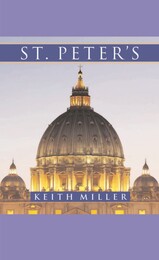 St. Peter’s
Keith Miller
Harvard University Press, 2007 Built by the decree of Constantine, rebuilt by some of the most distinguished architects in Renaissance Italy, emulated by Hitler’s architect in his vision for Germania, immortalized on film by Fellini, and fictionalized by a modern American bestseller, St. Peter’s is the most easily recognizable church in the world. This book is a cultural history of one of the most significant structures in the West. It bears the imprint of Bramante, Raphael, Michelangelo, Bernini, and Canova. For Grand Tourists of the eighteenth century, St. Peter’s exemplified the sublime. It continues to fascinate visitors today and appears globally as a familiar symbol of the papacy and of the Catholic Church itself.
The church was first built in the fourth century on what is thought to be the tomb of Peter—the rock upon which Christ decreed his church shall be built. After twelve hundred years, the church was largely demolished and rebuilt in the sixteenth century when it came to acquire its present-day form. St. Peter’s awes the visitor by its gigantic proportions, creating a city within itself. It is the mother church, the womb from which churches around the world have taken inspiration. This book covers the social, political, and architectural history of the church from the fourth century to the present. From the threshold, to the subterranean Roman necropolis, to the dizzying heights of the dome, this book provides rare perspectives and contexts for understanding the shape and significance of the most illustrious church in the world.
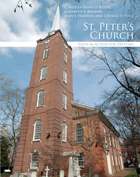 St. Peter's Church: Faith in Action for 250 Years
Cornelia Frances Biddle
Temple University Press, 2011 Celebrating 250 years, St. Peter's Episcopal Church in the Society Hill neighborhood of Philadelphia, has witnessed a rich mixture of people and events that reflect critical periods of American political and cultural history. George Washington worshiped here as did abolitionists and slave holders, Whigs, Democrats, and Republicans. St. Peter's was a point of first contact for thousands of immigrants, and the church opened schools for immigrants to help them to acculturate to life in Philadelphia. Opening a window onto colonial Philadelphia and the nation's histories, St. Peter's Church is a glorious testament to this National Historic Landmark. In addition to the stories and hundreds of black-and-white and color photographs, this handsome volume provides a history of the grounds, the churchyard, and the church itself-a classic example of eighteenth-century Philadelphia design that later incorporated the work of renown architects William Strickland, Thomas U. Walter, and Frank Furness.
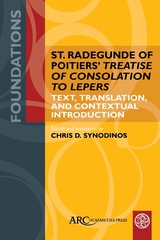 St. Radegunde of Poitiers’ "Treatise of Consolation to Lepers": Text, Translation, and Contextual Introduction
Chris D. Synodinos
Arc Humanities Press, 2025 This book presents the first English translation of an important early work on the subject of disability and human suffering. Dating from about the sixth century AD, and previously unidentified or attributed to Ps.-Basil, the text was intended as a sermon of comfort for victims of leprosy. An incurable and socially marginalizing affliction known to all ancient cultures, this disease defined its victims as “unclean,” as distinct from other sicknesses. A consolatory sermon, this treatise shares some features with the pre-Christian literary genre of consolation. The writer speaks to the lepers with words of comfort beyond their present suffering and reminds them of the glorious new body they will have in the resurrection. Synodinos shows that this treatise was the work of St. Radegunde of Poitiers, a monastic Frankish queen who lived a life of self-denial and whose significance deserves to be better understood.
St. Thomas Aquinas
Ralph McInerny
University of Notre Dame Press, 1982 "McInerny . . . does a good job of relating the key concepts in Aquinas's natural and supernatural theologies. This is a reliable introduction for people who are not already experts in Thomistic studies--and it has many insights for those few who are." —Vernon J. Bourke
St. Thomas Aquinas enables the reader to appreciate both Thomas's continuity with earlier thought and his creative independence. After a useful account of the life and work of St. Thomas, McInerny shows how the thoughts of Aristotle, Boethius, and Augustine and Pseudo-Dionysius were assimilated into the personal wisdom of St. Thomas. He also offers a helpful study of the distinctive features of Aquinas's Christian theology.
St. Thomas Aquinas and the Natural Law Tradition: Contemporary Perspectives
John Goyette
Catholic University of America Press, 2004 To explore and evaluate the current revival, this volume brings together many of the foremost scholars on natural law. They examine the relation between Thomistic natural law and the larger philosophical and theological tradition. Furthermore, they assess the contemporary relevance of St. Thomas's natural law doctrine to current legal and political philosophy.
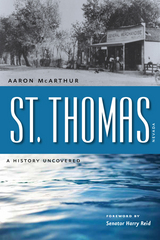 St. Thomas, Nevada: A History Uncovered
Aaron McArthur
University of Nevada Press, 2013 The history of St. Thomas, Nevada, the remains of which today lay under the high water mark of Lake Mead, begins in 1865 with Mormon missionaries sent by Brigham Young to the Moapa Valley to grow cotton. In 1871 the boundary of Utah territory was shifted east by one degree longitude, and the town became part of Nevada. New settlers moved in, miners and farmers, interacting with the Mormons and native Paiutes. The building of Hoover Dam doomed the small settlement, yet a striking number of people still have connections to a town that ceased to exist three-quarters of a century ago. Today, the ruins of this ghost town, just sixty miles east of Las Vegas, are visible when the waters of Lake Mead are low. Located in a national recreation area, the National Park Service today preserves and interprets the remains of St. Thomas as a significant historical site. Touching as it does upon on early explorers, Mormons, criminals, railroad and auto transportation, mining, water, state and federal relations, and more, St. Thomas, Nevada offers much to Mormon and regional historians, as well as general readers of western history.
The St. Thomas Way and the Medieval March of Wales: Exploring Place, Heritage, Pilgrimage
Catherine A. M. Clarke
Arc Humanities Press, 2020 The St. Thomas Way is a new heritage route from Swansea to Hereford which invites visitors to step into history of the medieval March of Wales. This multi-faceted volume offers new insights into the story of St. Thomas of Hereford, medieval and modern-day pilgrimage, professional aspects of heritage, tourism and regional development, and the application of digital methods and tools in heritage contexts. It also reflects on the St. Thomas Way as a spiritual and artistic experience.
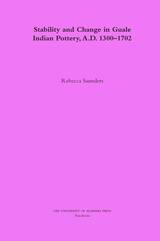 Stability and Change in Guale Indian Pottery, A.D. 1300-1702
Rebecca Saunders
University of Alabama Press, 2000 Through a comprehensive study of changing pottery attributes, Saunders documents the clash of Spanish and Native American cultures in the 16th-century southeastern United States. By studying the ceramic traditions of the Guale Indians, Rebecca Saunders provides evidence of change in Native American lifeways from prehistory through European contact and the end of the Mission period. The Guale were among the first southeastern groups to come into contact with Spanish and French colonists, and they adapted various strategies in order to ensure their own social survival. That adaptation is reflected, Saunders shows, in the changing attributes of pottery recovered on archaeological sites on the coasts of Georgia and Florida. Saunders traces the evolution of Guale pottery from the late prehistoric Irene phase through the Mission period at the three archaeological sites. She uses both technological and stylistic attributes to monitor change, paying particular attention to changes in execution and frequency of the filfot cross—a stylized cross that is a symbol of Guale cosmology. The frequency of this symbol in different ceramic components, according to Saunders, is a measure of change in the worldview of the missionized Guale. Although the symbol abruptly changed after the first Spanish contact, it showed remarkable stability through the Mission period, suggesting that traditional craft training and production remained strong despite high mortality rates and frequent relocation. Only after 1684, when the Guale were relocated to Amelia Island in present-day Florida, did the use of the cross motif decline, suggesting that the Guale who remained in Spanish territory may have conceived of their place in the cosmos differently from their forebears or their contemporaries who fled to the interior.
 Stability and Strife: England, 1714–1760
W. A. Speck
Harvard University Press This sparkling account of the great age of Whiggery during the reigns of George I and II is distinguished by its attention to social history. The author deftly explains how the political transformation which brought an end to the “rage of party” under Queen Anne and ushered in the “strife of faction” under the Hanoverians was related to social and economic conditions. This major political change brought stability to England and—by important, though incremental shifts in mobility, religion, agriculture, industry, and literacy—slowly transformed English society.
W. A. Speck argues that in 1714 England was ruled by rival elites called Tory and Whig and that by 1760 they had fused to form a ruling class. This union became possible as divisive issues faded and economic and political interests were shared. Whiggery itself, however, split apart for lesser reasons. “Country” Whigs were restorationists on moral and religious grounds while “Court” Whigs—neither Saints, nor Spartans, nor Reformers—created the mechanisms to realize the promise of the Glorious Revolution of 1689: mixed monarchy, property and liberty, and Protestantism.
Stability and Strife is the most up-to-date book in English eighteenth-century history in its methods—the use of social science data and literary sources—and in its sophisticated topical and narrative approaches to this fascinating era.
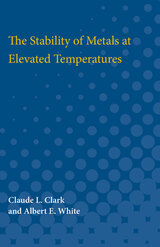 Stability of Metals at Elevated Temperatures
Claude L. Clark and Albert E. White
University of Michigan Press, 1928 The research in The Stability of Metals at Elevated Temperatures was undertaken for the purpose of answering three questions: first, what relation, if any, exists between the results obtained from short-time tensile and long-time creep tests?; second, what are the factors affecting the stability of metals at elevated temperatures?; and third, what mathematical relationship exists between the variables encountered in long-time testing?In regard to the first, it has been concluded that whether or not any relationship exists between these two forms of testing depends entirely upon the temperature range being considered.In regard to the second, it has been concluded that the stability may be increased by increasing the strength of the weakest phase present. That above the equi-cohesive temperature, the amorphous phase, is the weaker, while below, the crystalline phase is the weaker of the two.In regard to the third, mathematical equations have been developed connecting together stress and time for any particular temperature and any particular metal.
The Stable Boy: The First Witness Tells His Story
Shirley A. Taylor
Parkhurst Brothers, Inc., 2012 In writing a nativity story from the point of view of a boy who lives in the stable, Shirley Taylor has given us a vivid account of Christ’s birth and a motivating experience to readers and hearers, alike. Likely to become an ‘instant classic’ of Christian literature, this simple story will inspire thousands of retellings by pastors, Christian educators, parents and grandparents.
"Shirley Taylor's story gives readers and hearers insight into the town of Bethlehem at the time of the birth of Christ. Wendell Hall's illustrations help us imagine that scene wonderfully. The young homeless boy touches our hearts and imaginations. Not just for children, this is a read aloud book for all ages." - Lauretta Phillips, Storyteller, Author, Radio & TV Host
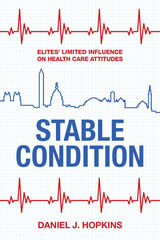 Stable Condition: Elites' Limited Influence on Health Care Attitudes
Daniel J. Hopkins
Russell Sage Foundation, 2023 The Affordable Care Act (ACA), the sweeping health care reform enacted by the Obama Administration in 2010, continues to be a contentious policy at the center of highly polarized political debates. Both before and after the law’s passage, political elites on both sides of the issue attempted to sway public opinion through two traditional approaches: messaging and policymaking itself. They operated under the assumption that the public’s personal experiences toward the law would make them more favorable. Yet these tried-and-true methods have had limited influence on public attitudes toward the ACA. Public opinion towards the ACA remained stable from 2010 to 2016, with more Americans opposing the law than supporting it. It was only after Donald Trump was elected in 2016 and the prospect of the law being repealed became a reality that public opinion swung in favor of the ACA. If traditional methods of influencing public opinion had little impact on attitudes towards the ACA, what did? In Stable Condition, political scientist Daniel J. Hopkins draws on survey data from 2009 to 2020 to assess how a variety of factors such as personal experience, political messaging, and partisanship did or did not affect public opinion on the ACA.
Hopkins finds that although personal experience with the ACA’s Medicaid expansion increased favorability among low-income Americans, it did not have a broader overall impact on public opinion. Personal experience with the Health Insurance Marketplace did not increase wider support for the ACA either. Due to the complex nature of the law, users of the Marketplace often did not realize they were benefiting from the ACA. Therefore, perceptions of the Marketplace were shaped by high-profile issues with the enrollment website and opposition to the individual mandate. These experiences ultimately offset one another, resulting in little discernable change in public opinion overall. Hopkins argues that political polarization was also responsible for elite’s limited influence and that public opinion on the ACA was largely determined by partisanship and political affiliation. Americans quickly aligned with their party’s stance on the law and were resistant to changing their beliefs despite the efforts of political elites.
Stable Condition is an illuminating examination of the limits of elites’ influence and the forces that shaped public opinion about the Affordable Care Act.
Stable Homotopy and Generalised Homology
J. F. Adams
University of Chicago Press, 1974 J. Frank Adams, the founder of stable homotopy theory, gave a lecture series at the University of Chicago in 1967, 1970, and 1971, the well-written notes of which are published in this classic in algebraic topology. The three series focused on Novikov's work on operations in complex cobordism, Quillen's work on formal groups and complex cobordism, and stable homotopy and generalized homology. Adams's exposition of the first two topics played a vital role in setting the stage for modern work on periodicity phenomena in stable homotopy theory. His exposition on the third topic occupies the bulk of the book and gives his definitive treatment of the Adams spectral sequence along with many detailed examples and calculations in KU-theory that help give a feel for the subject.
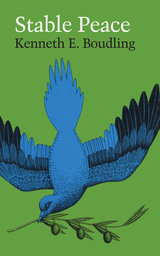 Stable Peace
By Kenneth E. Boulding; illustrations by Ed Lindlof
University of Texas Press, 1978 The human race has often put a high value on struggle, strife, turmoil, and excitement. Peace has been regarded as a utopian, unattainable, perhaps dull ideal or as some random element over which we have no control. However, the desperate necessities of the nuclear age have forced us to take peace seriously as an object of both personal and national policy. Stable Peace attempts to answer the question, If we had a policy for peace, what would it look like? A policy for peace aims to speed up the historically slow, painful, but persistent transition from a state of continual war and turmoil to one of continual peace. In a stable peace, the war-peace system is tipped firmly toward peace and away from the cycle of folly, illusion, and ill will that leads to war. Boulding proposes a number of modest, easily attainable, eminently reasonable policies directed toward this goal. His recommendations include the removal of national boundaries from political agendas, the encouragement of reciprocal acts of good will between potential enemies, the exploration of the theory and practice of nonviolence, the development of governmental and nongovernmental organizations to promote peace, and the development of research in the whole area of peace and conflict management. Written in straightforward, lucid prose, Stable Peace will be of importance to politicians, policy makers, economists, diplomats, all concerned citizens, and all those interested in international relations and the resolution of conflict.
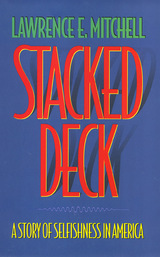 Stacked Deck: A Story of Selfishness in America
Lawrence E. Mitchell
Temple University Press, 1998 Americans for generations have been raised with the mantra that we can grow up to be anything we want to be, achieve anything we can imagine. How many of us believe the message? Dream big. It is a fundamental ideology of unbounded opportunity underscoring our drive to succeed. Yet for many Americans the reality, no matter how hard they try, is far from the visions of glory, the unattainable dream of rags to riches that leaves them feeling like failures.
To understand this ideology and its effect on society, Lawrence E. Mitchell instructs us to look at the myth of individualism that pervades our laws, our social thought, our institutions, and our philosophies. It is the touchstone of our national debates on welfare reform, salary equity, FDA regulations, and a criminal defendant's right to a fair trial -- and it even infiltrates our private lives every time we argue about the division of household chores or television time. In Stacked Deck, Mitchell shows us how this artificial reality buries the way we truly live.
Mithcell uses examples drawn from history, politics, law, and culture to show how our singular concern with fairness has diminished our sense of vulnerability, so that our ideas of justice, equality, and efficiency are modeled on the capabilities of the strongest in society. Large scale examples -- such as blue collar layoffs and corporate downsizing, natural disasters and catastrophic illnesses -- illustrates the rickety bridge between comfort and disaster. We must be reminded that we are all vulnerable to the forces of economics, society, politics, and nature. Thus, Mitchell proposes, those who start out at the top tend to stay there, just as the weak tend to remain weak.
Stacked Deck does more than outline this problem of American selfishness; it proposes a solution tha tis nothing less than a massive reconception of the way we relate to one another. Mitchell retains what is productive about the myth of the self-reliant individual, while asserting what is necessary to restore a sense of community. He suggests a sweeping intellectual recovery of fairness available to all levels of American society, thereby reclaiming our true sense of responsibility to others in society.
 Stacked Decks: Building Inspectors and the Reproduction of Urban Inequality
Robin Bartram
University of Chicago Press, 2022 A startling look at the power and perspectives of city building inspectors as they navigate unequal housing landscapes.
Though we rarely see them at work, building inspectors have the power to significantly shape our lives through their discretionary decisions. The building inspectors of Chicago are at the heart of sociologist Robin Bartram’s analysis of how individuals impact—or attempt to impact—housing inequality. In Stacked Decks, she reveals surprising patterns in the judgment calls inspectors make when deciding whom to cite for building code violations. These predominantly white, male inspectors largely recognize that they work within an unequal housing landscape that systematically disadvantages poor people and people of color through redlining, property taxes, and city spending that favor wealthy neighborhoods. Stacked Decks illustrates the uphill battle inspectors face when trying to change a housing system that works against those with the fewest resources.
 Stadium City: Sports and Media Infrastructure in the United States
Helen Morgan Parmett
University of Illinois Press, 2025 A new sports stadium has an outsized impact on a city’s landscape and image of itself. Each stadium also plays a central role in media institutions, technologies, and culture as a catalyst for urban change and flashy neighborhood anchor, cornerstone of regional identity and purveyor of multimedia experiences. Helen Morgan Parmett analyzes sports stadiums in Atlanta, Seattle, and Minneapolis to demonstrate the role that media institutions, technologies, and culture play in sports and examine their impact on the urban landscape. These interconnected factors impact struggles over city space, identity, and urban governing. As Morgan Parmett shows, stadiums exist as more than just buildings and sporting places—they are central nodes in the city that connect, disconnect, and distribute resources, people, information, and, ultimately, power. Morgan Parmett demonstrates how the “sportification” of place is influenced by the specific histories, geography, and sporting cultures of a city while explaining their relationship to broader forces at work in media, sport, and urbanism. Original and incisive, Stadium City offers a beyond-the-playing-field analysis of sports stadiums and their impact on our cities and our lives.
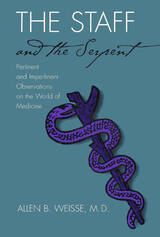 The Staff and the Serpent: Pertinent and Impertinent Observatioins on the World of Medicine
Allen B. Weisse, M.D.
Southern Illinois University Press, 1998
If laughter is good medicine, then the twenty-two essays offered here by Dr. Allen B. Weisse should prove a hearty antidote to a host of ills suffered by doctors, students and would-be students of medicine, amateur and professional medical historians, and, of course, patients, those of us who wonder what the medical profession is all about and how it affects us.
Often humorous and always informative, these essays cover a broad range of medical subjects. Weisse tackles medical ethics, offers advice to medical and premedical students and their families, delves into unusual episodes in medical history, confronts considerations of aging and self-image, and discusses the vagaries of rewards and recognition available from medical research. He also examines honesty in medical thinking, investigates ways of dealing with bureaucracies, and considers ways of learning to live with oneself. Finally, he evaluates the changing nature of medicine and medical research and looks into the roles of minorities and women in medicine.
Weisse knows whereof he speaks, enlivening each essay with personal anecdotes. When he explains past and current medical school admissions policies, for example, he approaches the subject with the combined knowledge of a former premedical student, a medical student, a faculty member, and an admissions chairperson over the past thirty years. As a medical researcher whose chief turned against him, he certainly knows what he is talking about in "Betrayal." He also writes with authority in his humorous account of how he, as a senior physician, struggles to keep on top of the overwhelming onslaught of medical advances ("Confessions of Creeping Obsolescence"). And in an essay to boost all of our spirits, he tells how an ivory tower physician (Weisse himself) gets drawn up in the service of the IRS bureaucracy and winds up tweaking its nose a bit ("In the Service of the IRS").
Perhaps nothing better illustrates the vigor, wit, and élan that characterize Weisse’s essays than his titles. "On Chinese Restaurants" deals with unusual syndromes and the way in which they have evolved and affected the way we look at ourselves. Other titles are "Pneumocystis and Me," "The Vanishing Male," "Say It Isn’t ‘No," "Bats in the Belfry or Bugs in the Belly?: Helicobacter and the Resurrection of Johannes Fibiger," and "PC: Politically Correct or Potentially Corrupting?"
Finally, two words in this book’s subtitle succinctly characterize Weisse’s essays: pertinent and impertinent—germane and irreverent information rakishly presented.
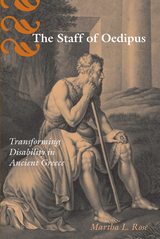 The Staff of Oedipus: Transforming Disability in Ancient Greece
Martha L. Rose
University of Michigan Press, 2013 Ancient Greek images of disability permeate the Western consciousness: Homer, Teiresias, and Oedipus immediately come to mind. But The Staff of Oedipus looks at disability in the ancient world through the lens of disability studies, and reveals that our interpretations of disability in the ancient world are often skewed. These false assumptions in turn lend weight to modern-day discriminatory attitudes toward disability. Martha L. Rose considers a range of disabilities and the narratives surrounding them. She examines not only ancient literature, but also papyrus, skeletal material, inscriptions, sculpture, and painting, and draws upon modern work, including autobiographies of people with disabilities, medical research, and theoretical work in disability studies. Her study uncovers the realities of daily life for people with disabilities in ancient Greece and challenges the translation of the term adunatos (unable) as "disabled," with all its modern associations.
Stage Blood: Vampires of the 19th Century Stage
Roxana Stuart
University of Wisconsin Press, 1994 The vampire originally took on its characteristics in the public imagination from a series of plays written and performed by some of the most important figures in nineteenth-century theater. This work is the first major study devoted to the vampire on stage; the author discusses the figure that preceded Dracula—Lord Ruthven—the subject of more than forty English, French, and American plays. The principal works are melodramas, but the vampire theme was also treated in tragedy, opera, ballet, burlesque, farce, burletta, and satire.
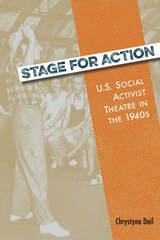 Stage for Action: U.S. Social Activist Theatre in the 1940s
Chrystyna Dail
Southern Illinois University Press, 2016 Drawing on underexplored and only recently available archives, author Chrystyna Dail examines the influence of Stage for Action, a theatre group founded in 1943, on social activist theatre in the 1940s, early 1950s, and beyond. The group embraced subjects not taken up by earlier activist theatre companies—advocating for the rights of Puerto Ricans, calling attention to the lack of child care for working mothers, and demanding the cessation of all nuclear warfare.
Exploring the intersection between performance and politics and the direct impact of the arts on social activism, Dail argues Stage for Action is a theatrical reflection of progressivism and the pro-working-class theatrical aesthetic of the 1940s. The theatre group, which used performance to encourage direct action and personal responsibility for change, eventually would function as the theatrical voice of the United States Progressive Party in the failed presidential campaign of former vice president Henry A. Wallace.
Calling into question the widely held belief that U.S. theatre in the early years of the Cold War was indifferent to activism, Stage for Action offers historians a new interpretation of social activist performance at midcentury.
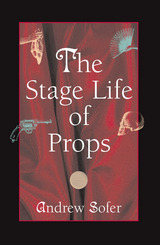 The Stage Life of Props
Andrew Sofer
University of Michigan Press, 2003 In The Stage Life of Props, Andrew Sofer aims to restore to certain props the performance dimensions that literary critics are trained not to see, then to show that these props are not just accessories, but time machines of the theater.
Using case studies that explore the Eucharistic wafer on the medieval stage, the bloody handkerchief on the Elizabethan stage, the skull on the Jacobean stage, the fan on the Restoration and early eighteenth-century stage, and the gun on the modern stage, Andrew Sofer reveals how stage props repeatedly thwart dramatic convention and reinvigorate theatrical practice.
While the focus is on specific objects, Sofer also gives us a sweeping history of half a millennium of stage history as seen through the device of the prop, revealing that as material ghosts, stage props are a way for playwrights to animate stage action, question theatrical practice, and revitalize dramatic form.
Andrew Sofer is Assistant Professor of English, Boston College. He was previously a stage director.
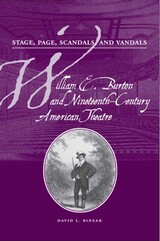 Stage, Page, Scandals, & Vandals: William E. Burton and Nineteenth-Century American Theatre
David L. Rinear
Southern Illinois University Press, 2004 In this first modern book-length biography of native Englander William E. Burton, theatre historian David L. Rinear explores Burton’s diary, letters, published reviews, and various reminiscences to reveal the tumultuous personal and professional lives of the mid-nineteenth-century actor/manager and his role in American literary history. Stage, Page, Scandals, and Vandals: William E. Burton and Nineteenth-Century American Theatre also provides insight into the cultural and artistic climate of an early period in American history when the country was still forming a national identity. Burton fled England in 1834 and came to America in the wake of a public scandal caused by his marriage to a sixteen-year-old orphan. Burton was then already married with a ten-year-old son. Settling in Philadelphia, the thirty-two-year-old actor rapidly established himself in the city’s theatrical productions and quickly became an audience favorite. In 1837, while continuing to act, Burton founded and edited The Gentleman’s Magazine, a monthly literary publication later called Burton’s Gentleman’s Magazine. Burton hired struggling author Edgar Allan Poe as coeditor, and the journal achieved literary acclaim as it first published many of Poe’s short stories and poems. Burton sold the journal in 1841 and used the money to build a new theatre, which he managed, although the depression of the early 1840s soon drove his venture out of business. After declaring bankruptcy the following year, Burton worked as a touring actor before returning to theatre management in 1845. For the next thirteen years, Burton managed a succession of theatres in Philadelphia, Baltimore, and New York. Burton’s work as a producer of Shakespearean comedies and romances marks him as the first of the intellectual theatre managers to raise the theatrical experience from mere popular culture to high art. Burton made a fortune in his ventures, amassed the finest private Shakespearean library in the country, and built a grand seaside estate in Glen Cove, Long Island. Shrewd in his personal affairs and in business, Burton also had a violent temper, which led him to viciously attack his competitors. His peculiar domestic relationships marred his brilliant career as an actor, manager, and man of letters; he may have been married to three women at once and lived with two of these women simultaneously. Fully revealing Burton’s contributions to American culture, Rinear traces Burton’s personal and professional pursuits from his emigration to his death in 1860. Bolstered by twenty-two illustrations, Stage, Page, Scandals, and Vandals sheds light on the history of American entertainment during the antebellum era, exposes the ruthless business practices required to succeed in theatre and literary magazine publishing, and reveals a sense of what constituted celebrity status in mid-nineteenth-century America.
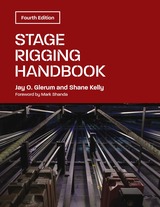 Stage Rigging Handbook, Fourth Edition
Jay O. Glerum and Shane Kelly with a foreword by Mark Shanda
Southern Illinois University Press, 2024 Updating the industry standard stage rigging text for a new generation
First published in 1987 and revised in 1997 and 2007, Stage Rigging Handbook remains the only book in any language that covers the design, operation, and maintenance of stage rigging equipment. Though often unnoticed, these systems are critical in both easing the workload of stage technicians and creating storytelling magic for the audience. This landmark text imparts the foundations for understanding and implementing rigging systems, such that upon completion of the book, the reader is ready to begin hands-on training and practice.
Organized into four sections, the handbook combines research and practical experience to guide riggers through their work. It begins by explaining the construction and care of basic lifting media. Part two analyzes types of rigging systems; then the handbook details the forces that impact rigging, from Newtonian physics to calculating expansive modern systems. Finally, it presents day-to-day best safety practices, including brand new sections on risk assessment and fall protection.
This reorganized and greatly expanded fourth edition of Jay O. Glerum’s industry standard text updates much of the information in the previous editions with the addition of chapters on truss (the framework that supports lighting, screens, and other accessories), motorized chain hoists, hardware, and job safety, including fall protection systems. Award-winning production manager Shane Kelly preserves Glerum’s voice while bringing fresh information to a new generation of riggers, supplementing the text with updated versions of earlier photographs and drawings as well as an additional one hundred illustrations. The handbook facilitates the development of a rigging practice rooted in safety, precision, and professionalism.
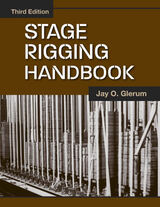 Stage Rigging Handbook, Third Edition
Jay O. Glerum
Southern Illinois University Press, 2007 Succinct and jargon free, Stage Rigging Handbook remains the only book in any language that covers the design, operation, and maintenance of stage-rigging equipment. It is written in an at-a-glance outline form, yet contains in-depth information available nowhere else. This fully indexed third edition includes three new parts: the first, an explanation of inspection procedures for rigging systems; the second, a discussion of training in the operation of rigging systems; and the third, essential information about the operation of fire curtains. The remaining six parts, as well as the glossary and bibliography, have been updated. This edition also contains a new preface, many new illustrations, and expanded information on Nicopress terminations.
Glerum explains that four main principles make up the core of this book: know the rigging system; keep it in safe working order; know how to use it; and keep your concentration. Glerum applies these principles to all of the major types of stage rigging systems, including block and tackle, hemp, counterweight, and motorized. He describes each type of rigging, then thoroughly reviews the operating procedures and methods of inspecting existing systems.
Stagecoach and Tavern Tales of the Old Northwest
Harry Ellsworth Cole. Edited by Louise Phelps Kellogg. Foreword by Patrick J. Brunet
Southern Illinois University Press, 1997 One journalist curious about life in the taverns along the stagecoach lines in Wisconsin and northern Illinois from the early 1800s until the 1880s was Harry Ellsworth Cole. While he could not sample strong ales at all of the taverns he wrote about, Cole did study newspaper accounts, wrote hundreds of letters to families of tavern owners, read widely in regional history, and traveled extensively throughout the territory. The result, according to Brunet, is a "nostalgic, sometimes romantic, well-written, and easily digested social history." At Cole’s death, historian Louise Phelps Kellogg edited his manuscript, which in this case involved turning his notes and illustrations into a book and publishing it with the Arthur H. Clark Company in 1930.
Stagecraft for Nonprofessionals
F. A. Buerki; Revised by Susan J. Christensen
University of Wisconsin Press, 1983 As the nonprofessional theatre continues to grow in popularity, its technology expands at a dizzying rate, presenting exciting new opportunities and challenges for all nonprofessional theatre craftsmen. This new edition of a stage manager’s old friend takes into account many aspects of the new theatre technology, insuring the book’s lasting place in college, high school, and community theatres everywhere. It is a book more likely to be found backstage on a stepladder than on a library shelf, and this is exactly what the author has intended. The emphasis is on simplicity, economy, and practicability. It is a book that can help now to put any play into production.
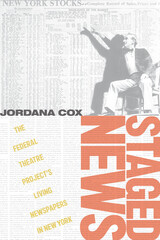 Staged News: The Federal Theatre Project’s Living Newspapers in New York
Jordana Cox
University of Massachusetts Press, 2023 Finalist for the 2023 Frank Luther Mott - Kappa Tau Alpha Journalism and Mass Communication Research Award
In 1935, a group of journalists and theater artists embarked on an unusual collaboration. With funds from the Federal Theatre Project (FTP), a Depression-era employment initiative established by President Roosevelt’s New Deal, they set out to produce news for the theatrical stage. Over the next four years, the New York–based team created six productions, known as the Living Newspapers. Covering a variety of public issues that included affordable housing, the plight of Dust Bowl farmers, the Tennessee Valley Authority, and labor law, Living Newspaper productions would reach hundreds of thousands of spectators and inspire adaptations across the country. Staged News interprets the Living Newspaper’s process and repertoire amid journalists’ changing conceptions of their profession. Jordana Cox spotlights marginalized “newsmakers,” particularly Black artists, who challenged the parameters of public knowledge and assumptions surrounding newsworthiness. This timely analysis reveals how a vital theatrical form sprouted from a changing news landscape and reimagined what journalism could do for people seeking democratic change.
 Staged Otherness: Ethnic Shows in Central and Eastern Europe, 1850–1939
Dagnoslaw Demski
Central European University Press, 2022 The cultural phenomenon of exhibiting non-European people in front of the European audiences in the 19th and 20th century was concentrated in the metropolises in the western part of the continent. Nevertheless, traveling ethnic troupes and temporary exhibitions of non-European humans took place also in territories located to the east of the Oder river and Austria. The contributors to this edited volume present practices of ethnographic shows in Russia, Poland, Czechia, Slovenia, Hungary, Germany, Romania, and Austria and discuss the reactions of local audiences. The essays offer critical arguments to rethink narratives of cultural encounters in the context of ethnic shows. By demonstrating the many ways in which the western models and customs were reshaped, developed, and contested in Central and Eastern European contexts, the authors argue that the dominant way of characterizing these performances as “human zoos” is too narrow. The contributors had to tackle the difficult task of finding traces other than faint copies of official press releases by the tour organizers. The original source material was drawn from local archives, museums, and newspapers of the discussed period. A unique feature of the volume is the rich amount of images that complement every single case study of ethnic shows.
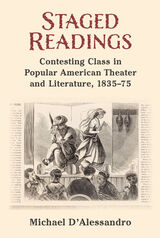 Staged Readings: Contesting Class in Popular American Theater and Literature, 1835-75
Michael D’Alessandro
University of Michigan Press, 2022 Staged Readings studies the social consequences of 19th-century America’s two most prevalent leisure forms: theater and popular literature. In the midst of watershed historical developments—including numerous waves of immigration, two financial Panics, increasing wealth disparities, and the Civil War—American theater and literature were developing at unprecedented rates. Playhouses became crowded with new spectators, best-selling novels flew off the shelves, and, all the while, distinct social classes began to emerge. While the middle and upper classes were espousing conservative literary tastes and attending family matinees and operas, laborers were reading dime novels and watching downtown spectacle melodramas like Nymphs of the Red Sea and The Pirate’s Signal or, The Bridge of Death!!! As audiences traveled from the reading parlor to the playhouse (and back again), they accumulated a vital sense of social place in the new nation. In other words, culture made class in 19th-century America.
Based in the historical archive, Staged Readings presents a panoramic display of mid-century leisure and entertainment. It examines best-selling novels, such as Harriet Beecher Stowe’s Uncle Tom’s Cabin and George Lippard’s The Quaker City. But it also analyzes a series of sensational melodramas, parlor theatricals, doomsday speeches, tableaux vivant displays, curiosity museum exhibits, and fake volcano explosions. These oft-overlooked spectacles capitalized on consumers’ previous cultural encounters and directed their social identifications. The book will be particularly appealing to those interested in histories of popular theater, literature and reading, social class, and mass culture.
 "The Stage's Glory": John Rich (1692–1761)
Berta Joncus
University of Delaware Press, 2011 John Rich (1692-1761) was a profoundly influential figure of the eighteenth-century London stage. As producer, manager, and performer, he transformed the urban entertainment market, creating genres and promotional methods still with us today. This volume gives the first comprehensive overview of Rich’s multifaceted career, appreciation of which has suffered from his performing identity as Lun, London’s most celebrated Harlequin. Far from the lightweight buffoon that this stereotype has suggested, Rich—the first producer of The Beggar’s Opera, the founder of Covent Garden, the dauntless backer of Handel, and the promoter of the principal dancers from the Parisian opera—is revealed as an agent of changes much more enduring than those of his younger contemporary, David Garrick. Contributions by leading scholars from a range of disciplines—theatre, dance, music, art, and cultural history—provide detailed analyses of Rich’s productions and representations. These findings complement Robert D. Hume’s lead article, a study that radically alters our perception of Rich.
Published by University of Delaware Press. Distributed worldwide by Rutgers University Press.
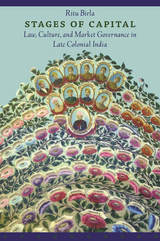 Stages of Capital: Law, Culture, and Market Governance in Late Colonial India
Ritu Birla
Duke University Press, 2009 In Stages of Capital, Ritu Birla brings research on nonwestern capitalisms into conversation with postcolonial studies to illuminate the historical roots of India’s market society. Between 1870 and 1930, the British regime in India implemented a barrage of commercial and contract laws directed at the “free” circulation of capital, including measures regulating companies, income tax, charitable gifting, and pension funds, and procedures distinguishing gambling from speculation and futures trading. Birla argues that this understudied legal infrastructure institutionalized a new object of sovereign management, the market, and along with it, a colonial concept of the public. In jurisprudence, case law, and statutes, colonial market governance enforced an abstract vision of modern society as a public of exchanging, contracting actors free from the anachronistic constraints of indigenous culture. Birla reveals how the categories of public and private infiltrated colonial commercial law, establishing distinct worlds for economic and cultural practice. This bifurcation was especially apparent in legal dilemmas concerning indigenous or “vernacular” capitalists, crucial engines of credit and production that operated through networks of extended kinship. Focusing on the story of the Marwaris, a powerful business group renowned as a key sector of India’s capitalist class, Birla demonstrates how colonial law governed vernacular capitalists as rarefied cultural actors, so rendering them illegitimate as economic agents. Birla’s innovative attention to the negotiations between vernacular and colonial systems of valuation illustrates how kinship-based commercial groups asserted their legitimacy by challenging and inhabiting the public/private mapping. Highlighting the cultural politics of market governance, Stages of Capital is an unprecedented history of colonial commercial law, its legal fictions, and the formation of the modern economic subject in India.
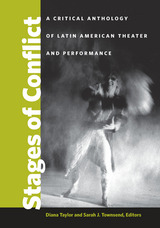 Stages of Conflict: A Critical Anthology of Latin American Theater and Performance
Diana Taylor and Sarah J. Townsend, Editors
University of Michigan Press, 2008 "An invaluable resource to teachers of Latin American theater, with texts that provide an accurate panorama of Latin American theater."
---Adam Versenyi, University of North Carolina at Chapel Hill "A most welcome and needed collection . . . Not only is it the first English-language anthology of theater and performance in Latin America from the Conquest onward, but it also includes excellent introductory and background material . . . certain to become an essential source book."
---Marvin Carlson, City University of New York "A rich resource for teachers and students, and for everyone intrigued by the history of performing Latin America . . . Diana Taylor and Sarah Townsend locate an animating tension between indigenous and colonial performance practices, and between the irreducibly local character of performance and the insistent pressure---as visible in the sixteenth century as in the twenty-first---of a globalizing, often oppressive modernity."
---W. B. Worthen, Barnard College, Columbia University Stages of Conflict brings together a vast array of dramatic texts, ambitiously tracing the intersection of theater and social and political life in the Americas over the past five centuries. Including eighteen works faithfully translated into English, the collection moves from a sixteenth century Mayan dance-drama to a 2003 production by the first published indigenous playwright in Mexico. Historical pieces from the sixteenth century to the present highlight the encounter between indigenous tradition and colonialism, while contributions from modern playwrights such as Virgilio Pinero, Jose Triana, and Denise Stolkos take on the tumultuous political and social upheavals of the past century. The editors have added comprehensive critical commentary that details the origins of each play, affording scholars and students of theater, performance studies, and Latin American studies the opportunity to view the history of a continent through its rich and diverse theatrical traditions. Diana Taylor is Director of The Hemispheric Institute of Performance and Politics and Professor of Performance Studies and Spanish at New York University. Her books include the award-winning volume The Archive and the Repertoire: Performing Cultural Memory in the Americas. Sarah J. Townsend is a doctoral student at New York University.
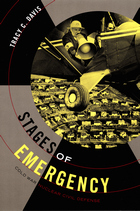 Stages of Emergency: Cold War Nuclear Civil Defense
Tracy C. Davis
Duke University Press, 2007 In an era defined by the threat of nuclear annihilation, Western nations attempted to prepare civilian populations for atomic attack through staged drills, evacuations, and field exercises. In Stages of Emergency the distinguished performance historian Tracy C. Davis investigates the fundamentally theatrical nature of these Cold War civil defense exercises. Asking what it meant for civilians to be rehearsing nuclear war, she provides a comparative study of the civil defense maneuvers conducted by three NATO allies—the United States, Canada, and the United Kingdom—during the 1950s and 1960s. Delving deep into the three countries’ archives, she analyzes public exercises involving private citizens—Boy Scouts serving as mock casualties, housewives arranging home protection, clergy training to be shelter managers—as well as covert exercises undertaken by civil servants. Stages of Emergency covers public education campaigns and school programs—such as the ubiquitous “duck and cover” drills—meant to heighten awareness of the dangers of a possible attack, the occupancy tests in which people stayed sequestered for up to two weeks to simulate post-attack living conditions as well as the effects of confinement on interpersonal dynamics, and the British first-aid training in which participants acted out psychological and physical trauma requiring immediate treatment. Davis also brings to light unpublicized government exercises aimed at anticipating the global effects of nuclear war. Her comparative analysis shows how the differing priorities, contingencies, and social policies of the three countries influenced their rehearsals of nuclear catastrophe. When the Cold War ended, so did these exercises, but, as Davis points out in her perceptive afterword, they have been revived—with strikingly similar recommendations—in response to twenty-first-century fears of terrorists, dirty bombs, and rogue states.
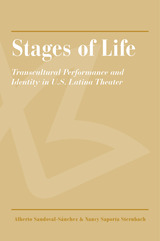 Stages of Life: Transcultural Performance and Identity in U.S. Latina Theater
Alberto Sandoval-Sánchez
University of Arizona Press, 2001 Latina theater and solo performance emerged in the 1990s as vibrant, energetic new genres found on stages from New York to Los Angeles. Many women now work in all aspects of Latina theater—often as playwrights or solo performers—with practitioners ranging from teenagers to grandmothers. Alberto Sandoval-Sánchez and Nancy Saporta Sternbach have previously published a groundbreaking anthology of Latina theater, Puro Teatro. They now offer a critical analysis of theatrical works, presenting a theoretical perspective from which to examine, understand, and contextualize Latina theater as a genre in its own right.
This is the first in-depth study of the entire corpus of Latina theater, based on close readings of works both published and in manuscript. It considers a large body of productions and performances, including works by such internationally known authors as Dolores Prida, Cherríe Moraga, and Janis Astor del Valle.
Applying feminist and postcolonial theory as well as theories of transculturation, Sandoval-Sánchez and Sternbach show how, despite cultural differences among Latinas, their works share a common poetics by building upon the politics of representation, identity, and location. In addition to covering theater, this study also shows that solo performance has its own history, properties, structure, and poetics. It examines performances of Carmelita Tropicana, Monica Palacios, and Marga Gomez—artists whose hybrid identities as Latina lesbians constitute living examples of transculturation in the making—to show how solo performance has roots in and digresses from more traditional modes of theater. With their Latina heritage as a unifying link, these women reflect common traits, patterns, dramatic structures, and properties that overcome regional differences. Stages of Life reads these eclectic cultural productions as a unified body of work that contributes to the formation of Latina identity in America today.
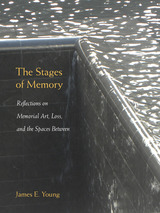 The Stages of Memory: Reflections on Memorial Art, Loss, and the Spaces Between
James E. Young
University of Massachusetts Press, 2016 Winner of the 2017 National Council on Public History Book Award
From around the world, whether for New York City's 9/11 Memorial, at exhibits devoted to the arts of Holocaust memory, or throughout Norway's memorial process for the murders at Utøya, James E. Young has been called on to help guide the grief stricken and survivors in how to mark their losses. This poignant, beautifully written collection of essays offers personal and professional considerations of what Young calls the "stages of memory," acts of commemoration that include spontaneous memorials of flowers and candles as well as permanent structures integrated into sites of tragedy. As he traces an arc of memorial forms that spans continents and decades, Young returns to the questions that preoccupy survivors, architects, artists, and writers: How to articulate a void without filling it in? How to formalize irreparable loss without seeming to repair it?
Richly illustrated, the volume is essential reading for those engaged in the processes of public memory and commemoration and for readers concerned about how we remember terrible losses.
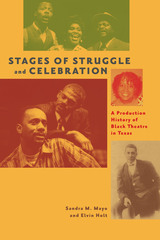 Stages of Struggle and Celebration: A Production History of Black Theatre in Texas
By Sandra M. Mayo and Elvin Holt
University of Texas Press, 2015 From plantation performances to minstrel shows of the late nineteenth century, the roots of black theatre in Texas reflect the history of a state where black Texans have continually created powerful cultural emblems that defy the clichés of horses, cattle, and bravado. Drawing on troves of archival materials from numerous statewide sources, Stages of Struggle and Celebration captures the important legacies of the dramatic arts in a historical field that has paid most of its attention to black musicians. Setting the stage, the authors retrace the path of the cakewalk and African-inspired dance as forerunners to formalized productions at theaters in the major metropolitan areas. From Houston’s Ensemble and Encore Theaters to the Jubilee in Fort Worth, gospel stage plays of the Black Academy of Arts and Letters in Dallas, as well as San Antonio’s Hornsby Entertainment Theater Company and Renaissance Guild, concluding with ProArts Collective in Austin, Stages of Struggle and Celebration features founding narratives, descriptions of key players and memorable productions, and enlightening discussions of community reception and the business challenges faced by each theatre. The role of drama departments in historically black colleges in training the companies’ founding members is also explored, as is the role the support of national figures such as Tyler Perry plays in ensuring viability. A canon of Texas playwrights completes the tour. The result is a diverse tribute to the artistic legacies that continue to inspire new generations of producers and audiences.
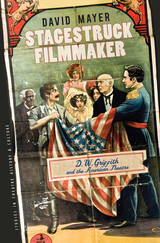 Stagestruck Filmmaker: D. W. Griffith and the American Theatre
David Mayer
University of Iowa Press, 2009 An actor, a vaudevillian, and a dramatist before he became a filmmaker, D. W. Griffith used the resources of theatre to great purpose and to great ends. In pioneering the quintessentially modern medium of film from the 1890s to the 1930s, he drew from older, more broadly appealing stage forms of melodrama, comedy, vaudeville, and variety. In Stagestruck Filmmaker, David Mayer brings Griffith’s process vividly to life, offering detailed and valuable insights into the racial, ethnic, class, and gender issues of these transitional decades.
Combining the raw materials of theatre, circus, minstrelsy, and dance with the newer visual codes of motion pictures, Griffith became the first acknowledged artist of American film. Birth of a Nation in particular demonstrates the degree to which he was influenced by the racist justifications and distorting interpretations of the Civil War and the Reconstruction era. Moving through the major phases of Griffith’s career in chapters organized around key films or groups of films, Mayer provides a mesmerizing account of the American stage and cinema in the final years of the nineteenth century and the first three decades of the twentieth century.
Griffith’s relationship to the theatre was intricate, complex, and enduring. Long recognized as the dominant creative figure of American motion pictures, throughout twenty-six years of making more than five hundred films he pillaged, adapted, reshaped, revitalized, preserved, and extolled. By historicizing his representations of race, ethnicity, and otherness, Mayer places Griffith within an overall template of American life in the years when film rivaled and then surpassed the theatre in popularity.
 Stagestruck: Theater, AIDS, and the Marketing of Gay America
Sarah Schulman
Duke University Press, 1998 In Stagestruck noted novelist and outspoken critic Sarah Schulman offers an account of her growing awareness of the startling similarities between her novel People in Trouble and the smash Broadway hit Rent. Written with a powerful and personal voice, Schulman’s book is part gossipy narrative, part behind-the-scenes glimpse into the New York theater culture, and part polemic on how mainstream artists co-opt the work of “marginal” artists to give an air of diversity and authenticity to their own work. Rising above the details of her own case, Schulman boldly uses her suspicions of copyright infringement as an opportunity to initiate a larger conversation on how AIDS and gay experience are being represented in American art and commerce. Closely recounting her discovery of the ways in which Rent took materials from her own novel, Schulman takes us on her riveting and infuriating journey through the power structures of New York theater and media, a journey she pursued to seek legal restitution and make her voice heard. Then, to provide a cultural context for the emergence of Rent—which Schulman experienced first-hand as a weekly theater critic for the New York Press at the time of Rent’s premiere—she reveals in rich detail the off- and off-off-Broadway theater scene of the time. She argues that these often neglected works and performances provide more nuanced and accurate depictions of the lives of gay men, Latinos, blacks, lesbians and people with AIDS than popular works seen in full houses on Broadway stages. Schulman brings her discussion full circle with an incisive look at how gay and lesbian culture has become rapidly commodified, not only by mainstream theater productions such as Rent but also by its reduction into a mere demographic made palatable for niche marketing. Ultimately, Schulman argues, American art and culture has made acceptable a representation of “the homosexual” that undermines, if not completely erases, the actual experiences of people who continue to suffer from discrimination or disease. Stagestruck’s message is sure to incite discussion and raise the level of debate about cultural politics in America today.
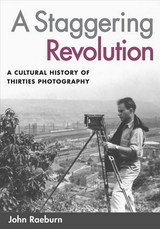 A Staggering Revolution: A Cultural History of Thirties Photography
John Raeburn
University of Illinois Press, 2006 During the 1930s, the world of photography was unsettled, exciting, and boisterous. John Raeburn's A Staggering Revolution recreates the energy of the era by surveying photography's rich variety of innovation, exploring the aesthetic and cultural achievements of its leading figures, and mapping the paths their pictures blazed public's imagination. While other studies of thirties photography have concentrated on the documentary work of the Farm Security Administration (FSA), no previous book has considered it alongside so many of the decade's other important photographic projects. A Staggering Revolution includes individual chapters on Edward Steichen's celebrity portraiture; Berenice Abbott's Changing New York project; the Photo League's ethnography of Harlem; and Edward Weston's western landscapes, made under the auspices of the first Guggenheim Fellowship awarded to a photographer. It also examines Margaret Bourke-White's industrial and documentary pictures, the collective undertakings by California's Group f.64, and the fashion magazine specialists, as well as the activities of the FSA and the Photo League.
 Stagg's University: The Rise, Decline, and Fall of Big-Time Football at Chicago
Robin Lester
University of Illinois Press, 1995 The legendary University of Chicago football program had an unusual beginning, a dazzling middle, and an inglorious conclusion. Its architect: Amos Alonzo Stagg, the most creative and entrepreneurial college coach of his time. A former all-American gridiron star at Yale, Stagg joined an elite academic institution that boasted intellectual notables like John Dewey, Thorstein Veblen, and Albert Michelson. Within fifteen years, the fame of Stagg's football program had eclipsed even Michelson's renown as the first American citizen to win a Nobel Prize. Robin Lester follows the commercial trail blazed by Stagg and University President William Rainey Harper and the subsequent transformation of college football into a mass entertainment industry that changed campuses and captured the national imagination. Fascinating and detailed, Stagg's Universityreveals how the University of Chicago's football industry prefigured today's billion-dollar sport juggernaut and details the life and leadership of one of its foundational personages.
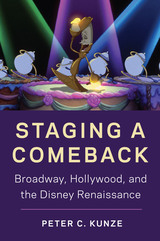 Staging a Comeback: Broadway, Hollywood, and the Disney Renaissance
Peter C. Kunze
Rutgers University Press, 2023 In the early 1980s, Walt Disney Productions was struggling, largely bolstered by the success of its theme parks. Within fifteen years, however, it had become one of the most powerful entertainment conglomerates in the world. Staging a Comeback: Broadway, Hollywood, and the Disney Renaissance argues that far from an executive feat, this impressive turnaround was accomplished in no small part by the storytellers recruited during this period. Drawing from archival research, interviews, and textual analysis, Peter C. Kunze examines how the hiring of theatrically trained talent into managerial and production positions reorganized the lagging animation division and revitalized its output. By Aladdin, it was clear that animation—not live action—was the center of a veritable “renaissance” at Disney, and the animated musicals driving this revival laid the groundwork for the company’s growth into Broadway theatrical production. The Disney Renaissance not only reinvigorated the Walt Disney Company but both reflects and influenced changes in Broadway and Hollywood more broadly.
Staging Ageing: Theatre, Performance and the Narrative of Decline
Michael Mangan
Intellect Books, 2013 How can plays and performances, past and present, inform our understanding of ageing? Drawing primarily on the Western dramatic canon, on contemporary British theater, on popular culture, and on paratheatrical practices, Staging Ageing investigates theatrical engagement with ageing from the Greek chorus to Reminiscence Theater. It also explores the relationship of the plays, performances, and practices to the material, social, and ideological conditions that produced them. A seminal work on the cultural past and present of ageing, the book will find grateful audiences not only among scholars but also among theater and health care professionals.
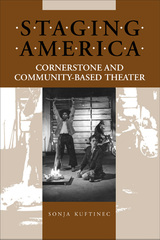 Staging America: Cornerstone and Community-Based Theater
Sonja Kuftinec
Southern Illinois University Press, 2005 This captivating studymaps a history and theory of community-based theater in the United States through the Cornerstone Theater Company. Detailing how the performance-making process contributes to an ongoing negotiation of American identity, Sonja Kuftinec investigates community-based theater to trace the historical affiliations of the form and critically examines how community-based theater both enables community and challenges the very notion of “community” as a stable site. The process of making and unmaking community is vividly illuminated in the work of the Cornerstone Theater Company, a Los Angeles-based ensemble founded in 1986. From 1986 to 1991, Cornerstone toured nationwide, working mainly with rural towns to create adaptations of classical texts. A Wild West musical Hamlet was performed with residents of Marmarth, North Dakota (population 190), and The House on Walker River, an adaptation of the Oresteia trilogy, was developed with a Native American reservation in Nevada. Since 1991, Cornerstone has performed with urban communities, developing original shows and adaptations of Western and non-Western texts incorporating local histories and community players. These performances rearticulate distinctions among various urban group and between amateur and professional theater.
While Cornerstone’s contemporary work can be contextualized within a historical tradition of grassroots performance, it also complicates this tradition, suggesting that identity may be more dynamic than rooted. By using Cornerstone as a case study, Kuftinec’s analysis of community-based theater’s impact upon rural, urban, and professional sites across the United States proposes that “community” and “America” are vital terms of negotiation rather than fixed entities.
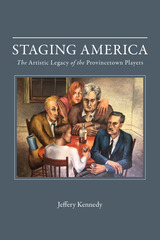 Staging America: The Artistic Legacy of the Provincetown Players
Jeffery Kennedy
University of Alabama Press, 2023 A comprehensive history of the Provincetown Players and their influence on modern American theatre
The Provincetown Players created a revolution in American theatre, making room for truly modern approaches to playwriting, stage production, and performance unlike anything that characterized the commercial theatre of the early twentieth century. In Staging America: The Artistic Legacy of the Provincetown Players, Jeffery Kennedy gives readers the unabridged story in a meticulously researched and comprehensive narrative that sheds new light on the history of the Provincetown Players. This study draws on many new sources that have only become available in the last three decades; this new material modifies, refutes, and enhances many aspects of previous studies.
At the center of the study is an extensive account of the career of George Cram Cook, the Players’ leader and artistic conscience, as well as one of the most significant facilitators of modernist writing in early twentieth-century American literature and theatre. It traces Cook’s mission of “cultural patriotism,” which drove him toward creating a uniquely American identity in theatre. Kennedy also focuses on the group of friends he calls the “Regulars,” perhaps the most radical collection of minds in America at the time; they encouraged Cook to launch the Players in Provincetown in the summer of 1915 and instigated the move to New York City in fall 1916.
Kennedy has paid particular attention to the many legends connected to the group (such as the “discovery” of Eugene O’Neill), and also adds to the biographical record of the Players’ forty-seven playwrights, including Susan Glaspell, Neith Boyce, Edna St. Vincent Millay, Floyd Dell, Rita Wellman, Mike Gold, Djuna Barnes, and John Reed. Kennedy also examines other fascinating artistic, literary, and historical personalities who crossed the Players’ paths, including Emma Goldman, Charles Demuth, Berenice Abbott, Sophie Treadwell, Theodore Dreiser, Claudette Colbert, and Charlie Chaplin. Kennedy highlights the revolutionary nature of those living in bohemian Greenwich Village who were at the heart of the Players and the America they were responding to in their plays.
Staging Asia: The Dutch East India Company and the Amsterdam Theatre
Manjusha Kuruppath
Leiden University Press, 2017 How is it possible that three playwrights in the early modern Dutch Republic wrote dramas based on contemporary political events in Asia? Reflecting on this remarkable phenomenon, Staging Asia traces the passage of the stories surrounding three political revolutions from seventeenth-century Asia through to the Dutch Republic and their ultimate manifestation as dramas. This book explores the nature of the representation of the Orient in these plays and evaluates how this characterization was influenced by the channels that these dramatists relied on to gather information for their works. As these dramas exhibit strong connections to the Dutch East India Company, this work additionally examines the role of that enterprise in disseminating information on Asia and producing imagery about the Orient.
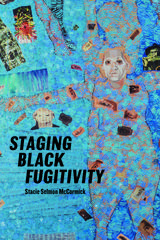 Staging Black Fugitivity
Stacie Selmon McCormick
Ohio State University Press, 2019 Staging Black Fugitivity asks: How does drama constitute an important site for ongoing conversations about slavery’s resonance and its legacies? To answer this question, Stacie Selmon McCormick charts the historical turn toward slavery in black drama that began in the last quarter of the twentieth century. This movement, spearheaded by August Wilson and Suzan-Lori Parks, has been largely under-theorized, yet it participates in and advances the neo-slave narrative genre—with contemporary black dramas enhancing the neo-slave narrative’s capacity to represent the visual, corporal, and affective dimensions of the black body and slavery as an institution.
McCormick traces the innovative ways that artists render slavery for present-day audiences. The dramas assembled in this book approach slavery from myriad perspectives—afrofuturist, feminist, and queer—in order to produce new imaginaries that offer more complex depictions of black experience. Through subverting notions of time, race, gender, and familiar histories of slavery themselves, the dramas under discussion produce performances of fugitivity—subversive, radical, and experimental performances of black artistic and political freedom at the site of slavery.
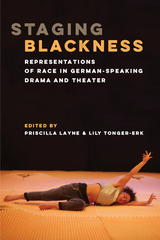 Staging Blackness: Representations of Race in German-Speaking Drama and Theater
Priscilla Dionne Layne and Lily Tonger-Erk, Editors
University of Michigan Press, 2024 Staging Blackness provides a multifaceted look at how Blackness has been staged in Germany from the eighteenth century, the birth of German national theater, until the present. In recent years, the German stage has been at the forefront of discussions about race, from cases of blackface to fights for better representation within the professional community. These debates frequently invoke larger discussions about the politics of race in German theater and their origins and beyond.
Written by scholars and theater professionals with a wide variety of historical and theoretical expertise, the chapters seek to explore the connections between the German discourse on national theater and emerging ideas about race, analyze how dramaturges deal with older representations of Blackness in current productions, and discuss the contributions Black German playwrights and dramaturges have made to this discourse. Historians question how these plays were staged in their time, while cultural studies scholars contemplate how to interpret the function of race in these plays and how they can continue to be staged today.
 Staging Buenos Aires: Theater, Society, and Politics in Argentina 1860-1920
Kristen McCleary
University of Pittsburgh Press, 2024 Staging Buenos Aires centers theater as a source of historical inquiry to understand how nonelites experienced and shaped a city undergoing dramatic transformations. Commercial theater constituted the core of the city’s public sphere, one in which middle-class playwrights and audiences assumed the leading role. Audiences and critics often disagreed about what was “acceptable” entertainment. Playwrights used theater to promote their own ideas of sociopolitical change, creating a space for working- and middle-class audiences to identify and push back against imposed regulations and attitudes. Cultural production on the city’s stages revealed fissures and social anxieties about the expansion of the political system and of the public sphere as women became increasingly visible in urban spaces. At the same time, theater also gave structure and meaning to these rapid changes, providing the space for the city’s playwrights and complex publics to play a key role in identifying, processing, and shaping the transforming nation. Plays helped audience members work through dramatic shifts in societal norms as urbanization and industrialization resulted in the visible decline of patriarchal social structures, made most visible in the urban sphere.
Staging China: The Politics of Mass Spectacle
Florian Schneider
Leiden University Press, 2019 The People’s Republic of China began the 21st century with a new-and-improved public relations approach that was meant to counter anxieties about China’s role in the world while simultaneously showcasing the leadership’s policies to a domestic audience. Crucial to this communication strategy have been networked spectacles: elaborate mass event, designed to reconfigure organisations, ideas, and the relations between people. In Staging China, Florian Schneider analyses large-scale projects like the Beijing Olympics and Shanghai Expo to show how such spectacles became part of the ruling party’s governance toolkit under Hu Jintao’s leadership, and how their legacy informs politics and political communication in China to this day.
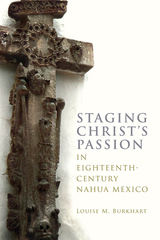 Staging Christ's Passion in Eighteenth-Century Nahua Mexico
Louise M. Burkhart
University Press of Colorado, 2023 Staging Christ’s Passion in Eighteenth-Century Nahua Mexico explores the Passion plays performed in Nahuatl (Aztec) by Indigenous Mexicans living under Spanish colonial occupation. Though sourced from European writings and devotional practices that emphasized the suffering of Christ and his mother, this Nahuatl theatrical tradition grounded the Passion story in the Indigenous corporate community. Passion plays had courted controversy in Europe since their twelfth-century origin, but in New Spain they faced Catholic authorities who questioned the spiritual and intellectual capacity of Indigenous people and, in the eighteenth century, sought to suppress these performances. Six surviving eighteenth-century scripts, variants of an original play possibly composed early in the seventeenth century, reveal how Nahuas passed along this model text while modifying it with new dialogue, characters, and stage techniques. Louise M. Burkhart explores the way Nahuas merged the Passion story with their language, cultural constructs, social norms, and religious practices while also responding to surveillance by Catholic churchmen. Analytical chapters trace significant themes through the six plays and key these to a composite play in English included in the volume. A cast with over fifty distinct roles acted out events extending from Palm Sunday to Christ’s death on the cross. One actor became a localized embodiment of Jesus through a process of investiture and mimesis that carried aspects of pre-Columbian materialized divinity into the later colonial period. The play told afar richer version of the Passion story than what later colonial Nahuas typically learned from their priests or catechists. And by assimilating Jesus to an Indigenous, or macehualli, identity, the players enacted a protest against colonial rule. The situation in eighteenth-century New Spain presents both a unique confrontation between Indigenous communities and Enlightenment era religious reformers and a new chapter in an age-old power game between popular practice and religious orthodoxy. By focusing on how Nahuas localized the universalizing narrative of Christ’s Passion, Staging Christ’s Passion in Eighteenth-Century Nahua Mexico offers an unusually in-depth view of religious life under colonial rule. Burkhart’s accompanying website also makes available transcriptions and translations of the six Nahuatl-language plays, four Spanish-language plays composed in response to the suppression of the Nahuatl practice, and related documentation, providing a valuable resource for anyone interested in consulting the original material. Comments restricted to single page plays composed in response to the suppression of the Nahuatl practice, and related documentation, providing a valuable resource for anyone interested in consulting the original material
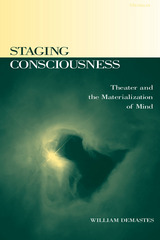 Staging Consciousness: Theater and the Materialization of Mind
William W. Demastes
University of Michigan Press, 2002 Staging Consciousness argues that theater is a living invalidation of the Western dualism of mind and body, activating human consciousness through its embodiment of thought in performance. While consciousness theory has begun to find ways to bridge dualist gaps, Staging Consciousness suggests that theater has anticipated these advances, given the ways in which the physical theater promotes nonphysical thought, connecting the two realms in unique and ingenious ways.
William W. Demastes makes use of the writings of such varied theater practitioners as Antonin Artaud, Jerzy Grotowski, Samuel Beckett, Tony Kushner, Sam Shepard, Spalding Gray, Peter Shaffer, and others, illuminating theater as proof that mind is an extension of body. The living stage incubates and materializes thought in a way that highlights the processes of daily existence outside the theater. This book offers a new way for theater practitioners to look at the unique value of the theater and an invitation for philosophers and scientists to search for new paradigms in theater, the oldest of art forms.
William W. Demastes is Professor of English, Louisiana State University. His previous books include Theatre of Chaos: Beyond Absurdism, into Disorderly Order.
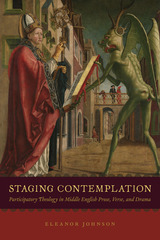 Staging Contemplation: Participatory Theology in Middle English Prose, Verse, and Drama
Eleanor Johnson
University of Chicago Press, 2018 What does it mean to contemplate? In the Middle Ages, more than merely thinking with intensity, it was a religious practice entailing utter receptiveness to the divine presence. Contemplation is widely considered by scholars today to have been the highest form of devotional prayer, a rarified means of experiencing God practiced only by the most devout of monks, nuns, and mystics.
Yet, in this groundbreaking new book, Eleanor Johnson argues instead for the pervasiveness and accessibility of contemplative works to medieval audiences. By drawing together ostensibly diverse literary genres—devotional prose, allegorical poetry, cycle dramas, and morality plays—Staging Contemplation paints late Middle English contemplative writing as a broad genre that operated collectively and experientially as much as through radical individual disengagement from the world. Johnson further argues that the contemplative genre played a crucial role in the exploration of the English vernacular as a literary and theological language in the fifteenth century, tracing how these works engaged modes of disfluency—from strained syntax and aberrant grammar, to puns, slang, code-switching, and laughter—to explore the limits, norms, and potential of English as a devotional language. Full of virtuoso close readings, this book demonstrates a sustained interest in how poetic language can foster a participatory experience of likeness to God among lay and devotional audiences alike.
 Staging Desire: Queer Readings of American Theater History
Kim Marra and Robert A. Schanke, Editors
University of Michigan Press, 2002 Staging Desire gathers critical and biographical essays on notable stage personalities who made their mark before 1969, when the Stonewall riots accelerated the lesbian and gay rights movement in the United States. How they staged their unconventional sexualities greatly influenced the course of their personal and professional lives, and thus the course of American theater history. The book builds on an earlier collection--the well-received Passing Performances, which focused on actors, directors, producers, and agents--by examining playwrights, lyricists, critics, and designers. Shaping theatrical representations from offstage, these practitioners exploited the special opportunities theater offered as a complex and many-layered medium for expression of transgressive desire.
Essays cover the careers of major figures Clyde Fitch, Rachel Crothers, Mercedes de Acosta, Djuna Barnes, Cole Porter, Lorenz Hart, George Kelly, William Inge, James "Acorn" Oaks, Adam "Vagabond" Badeau, Eric Bentley, Loie Fuller, Robert Edmond Jones, and Jean Rosenthal. Grounded in research into the history of sexuality, the book engages central problems of terminology and evidence in analyzing sexual practices of the past and the modes of articulation of sexuality in theater, conditioned by American culture's peculiar anxieties about both.
Kim Marra is Associate Professor of Theatre Arts, University of Iowa. Robert A. Schanke is Professor of Theatre, Central College, Iowa. They edited Passing Performances: Queer Readings of Leading Players in American Theater History, a previous volume in this series.
 Staging Desire: Queer Readings of American Theater History
Kim Marra and Robert A. Schanke, Editors
University of Michigan Press
Staging Desire gathers critical and biographical essays on notable stage personalities who made their mark before 1969, when the Stonewall riots accelerated the lesbian and gay rights movement in the United States. How they staged their unconventional sexualities greatly influenced the course of their personal and professional lives, and thus the course of American theater history. The book builds on an earlier collection--the well-received Passing Performances, which focused on actors, directors, producers, and agents--by examining playwrights, lyricists, critics, and designers. Shaping theatrical representations from offstage, these practitioners exploited the special opportunities theater offered as a complex and many-layered medium for expression of transgressive desire.
Essays cover the careers of major figures Clyde Fitch, Rachel Crothers, Mercedes de Acosta, Djuna Barnes, Cole Porter, Lorenz Hart, George Kelly, William Inge, James "Acorn" Oaks, Adam "Vagabond" Badeau, Eric Bentley, Loie Fuller, Robert Edmond Jones, and Jean Rosenthal. Grounded in research into the history of sexuality, the book engages central problems of terminology and evidence in analyzing sexual practices of the past and the modes of articulation of sexuality in theater, conditioned by American culture's peculiar anxieties about both.
Kim Marra is Associate Professor of Theatre Arts, University of Iowa. Robert A. Schanke is Professor of Theatre, Central College, Iowa. They edited Passing Performances: Queer Readings of Leading Players in American Theater History, a previous volume in this series.
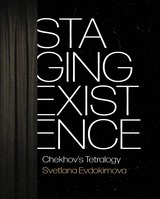 Staging Existence: Chekhov's Tetralogy
Svetlana Evdokimova
University of Wisconsin Press, 2023 Anton Chekhov is justly famous as an author and a playwright, with his work continuing to appear on stages around the world more than a century after his death. However, he is rarely studied for his intellectual and philosophical theories. His disinterest in developing a “unified idea”—in vogue for Russian intellectuals of his time—and his aversion to the maximalism characteristic of contemporary Russian culture and society set him apart from his fellow writers. As a result, Chekhov’s contribution to intellectual and philosophical discourse was obscured both by his contemporaries and by subsequent scholars.
Svetlana Evdokimova tackles this gap in Chekhov scholarship, examining the profound connections between his unstated philosophy and his artistic production. Arguing that Chekhov’s four major plays (The Cherry Orchard, Three Sisters, The Seagull, and Uncle Vanya) constitute a kind of cycle, Staging Existence offers a major reappraisal of this critical playwright in Russian intellectual history. Evdokimova’s deep, careful research into Chekhov’s engagement with contemporary philosophy provides insight into both Chekhov’s oeuvre and the writer himself.
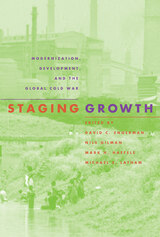 Staging Growth: Modernization, Development, and the Global Cold War
David C. Engerman
University of Massachusetts Press, 2003 Beginning in the 1950s, the theory of modernization emerged as the dominant paradigm of economic, social, and political development within the American foreign policy establishment. Purporting to explain the stages through which all nations pass on the road to industrial modernity, it provided a rationale for a broad range of cultural and political projects aimed at fostering Third World growth while simultaneously combating communism.
But modernization theory was more than simply an expression of Cold War ideology. As the essays in this volume show, the ideal of modernization proliferated throughout the postcolonial world and across ideological lines in places as diverse as East Asia, Southern Africa, and South Asia. Indeed, it was embraced by all who shared the American enthusiasm for the increased production and higher standards of living promised by industrialization -enemies and allies alike.
Situating modernization theory historically, Staging Growth avoids conventional chronologies and categories of analysis, particularly the traditional focus on conflicts between major powers. The contributors employ a variety of approaches-from economic and intellectual history to cultural criticism and biography-to shed fresh light on the global forces that shaped the Cold War and its legacies. Most of the pieces are comparative, exploring how different countries and cultures have grappled with the implications of modern development. At the same time, all of the essays address similar fundamental questions. Is modernization the same thing as Westernization? Is the idea of modernization universally valid? Do countries follow similar trajectories as they undertake development? Does modernization bring about globalization?
In addition to the editors and Akira Iriye, contributors include Michael Adas, Laura Belmonte, Gregg Andrew Brazinsky, Christina Klein, J. Victor Koschmann, and Michael R. Mahoney.
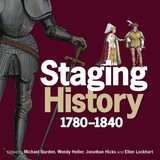 Staging History: 1780-1840
Edited by Michael Burden, Wendy Heller, Jonathan Hicks, and Ellen Lockhart
Bodleian Library Publishing, 2016 Throughout the late-eighteenth and early nineteenth centuries, historical events were tremendously popular as adaptations for the stage. From the Revolutionary War to the French Revolution, stage dramas brought history vividly to life through powerful vocal performances and visual spectacle. The scale of the production was often ambitious, such as a Sadler’s Well staging of the Great Siege of Gibraltar, which featured a large water tank with floating vessels. Another production on the same topic added live cannons, which set fire to the vessels during the performance!
Drawing on copious new research, Staging History reexamines extraordinary theatrical works of the period to show the role they played in shaping popular interpretations of history. Editors Michael Burden, Wendy Heller, Jonathan Hicks, and Ellen Lockhart are joined by other experts in the field in analyzing theatrical documents, including playbills, set designs, and musical scores, as well as paintings, prints, and other illustrations, in order to explore what counted as historical truth for the writers, performers, and audiences of these plays.
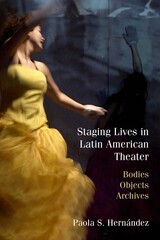 Staging Lives in Latin American Theater: Bodies, Objects, Archives
Paola S. Hernández
Northwestern University Press, 2021 Staging Lives in Latin American Theater: Bodies, Objects, Archives examines twenty‑first‑century documentary theater in Latin America, focusing on important plays by the Argentine director Vivi Tellas, the Argentine playwright and director Lola Arias, the Mexican theater collective Teatro Línea de Sombra, and the Chilean playwright and director Guillermo Calderón. Paola S. Hernández demonstrates how material objects and archives—photographs, videos, and documents such as witness reports, legal briefs, and letters—come to life onstage. Hernández argues that present-day, live performances catalog these material archives, expanding and reinterpreting the objects’ meanings. These performances produce an affective relationship between actor and audience, visualizing truths long obscured by repressive political regimes and transforming theatrical spaces into sites of witness. This process also highlights the liminality between fact and fiction, questioning the veracity of the archive.
Richly detailed, nuanced, and theoretically wide-ranging, Staging Lives in Latin American Theater reveals a range of interpretations about how documentary theater can conceptualize the idea of self while also proclaiming a new mode of testimony through theatrical practices.
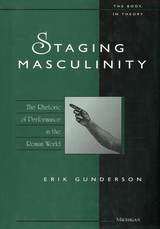 Staging Masculinity: The Rhetoric of Performance in the Roman World
Erik Gunderson
University of Michigan Press, 2000 Performance was one of the five canonical branches of oratory in the classical period, but it presents special problems that distinguish it from concerns such as composition and memory. The ancient performer was supposed to be a "good man" and his performance a manifestation of an authentic and authoritative manliness. But how can the orator be distinguished from a mere actor? And what is the proper role for the body, given that it is a potential object of desire?
Erik Gunderson explores these and other questions in ancient rhetorical theory using a variety of theoretical approaches, drawing in particular on the works of Judith Butler, Michel Foucault, and Jacques Lacan. His study examines the status of rhetorical theory qua theory, the production of a specific version of body in the course of its theoretical description, oratory as a form of self-mastery, the actor as the orator's despised double, the dangers of homoerotic pleasure, and Cicero's De Oratore, as what good theory and practice ought to look like.
Erik Gunderson is Assistant Professor of Greek and Latin, Ohio State University.
 Staging Memories: Hou Hsiao-hsien's A City of Sadness
Abé Mark Nornes and Emilie Yueh-yu Yeh
Michigan Publishing, 2015 In Staging Memories, authors Abé Mark Nornes and Emilie Yeh present an updated study of Hou Hsiao-hsien’s landmark contributions to Taiwanese and world cinema, with particular emphasis on A City of Sadness (Beiqing Chengshi), the winner of the Golden Lion award at the 1989 Venice Film Festival. Staging Memories is based on Narrating National Sadness, one of the first hypertext analyses in film studies, and its analysis is couched in a general history of Taiwan, the political massacre that A City of Sadness recreates, and the history of Taiwan New Cinema. This background information is crucial context for viewers, and one of the reasons teachers have long valued the hypertext version of the book. The body of the text analyzes Hou's style, representation of violence, and the complex manner in which he renders history in his oblique long-take style. The book ends with a chapter that examines a single sequence that unifies the various threads of the overall analysis.
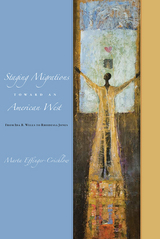 Staging Migrations toward an American West: From Ida B. Wells to Rhodessa Jones
Marta Effinger-Crichlow
University Press of Colorado, 2014 Staging Migrations toward an American West examines how black women's theatrical and everyday performances of migration toward the American West expose the complexities of their struggles for sociopolitical emancipation. While migration is often viewed as merely a physical process, Effinger-Crichlow expands the concept to include a series of symbolic internal journeys within confined and unconfined spaces. Four case studies consider how the featured women—activist Ida B. Wells, singer Sissieretta "Black Patti” Jones, World War II black female defense-industry workers, and performance artist Rhodessa Jones—imagined and experienced the American West geographically and symbolically at different historical moments. Dissecting the varied ways they used migration to survive in the world from the viewpoint of theater and performance theory, Effinger-Crichlow reconceptualizes the migration histories of black women in nineteenth- and twentieth-century America. This interdisciplinary study expands the understanding of the African American struggle for unconstrained movement and full citizenship in the United States and will interest students and scholars of American and African American history, women and gender studies, theater, and performance theory.
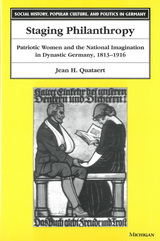 Staging Philanthropy: Patriotic Women and the National Imagination in Dynastic Germany, 1813-1916
Jean H. Quataert
University of Michigan Press, 2001 Staging Philanthropy is a history of women's philanthropic associations during Germany's "long" nineteenth century. Challenged by the French Revolution and the Napoleonic occupation and war, dynastic groups in Germany made community welfare and its defense part of newly-gendered social obligations, sponsoring a network of state women's associations, philanthropic institutions, and nursing orders which were eventually coordinated by the German Red Cross. These patriotic groups helped fashion an official nationalism that defended conservative power and authority in the new nation-state.
An original and truly multi-disciplinary work, Staging Philanthropy uses archival research to reconstruct the neglected history of women's philanthropic organizations during the 'long' nineteenth century. Borrowing from cultural anthropologists, Jean Quataert explores how meaning is created in the theater of politics. Linking gender with nationalism and war with humanitarianism, Quataert weaves her analysis together with themes of German historiography and the wider context of European history.
Staging Philanthropy will interest readers in German history, women's history, politics and anthropology, as well as those whose interest is in medicalization and the German Red Cross. This book situates itself in the middle of a string of debates pertaining to modern German history and, thus, should also appeal to readers from the general educated public.
Jean Quataert is Professor of History and Women's Studies, Binghamton University. She has previously published a number of books, including Connecting Spheres: European Women in a Globalizing World, 1500 to the Present with Marilyn J. Boxer (Oxford, 1999).
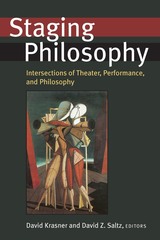 Staging Philosophy: Intersections of Theater, Performance, and Philosophy
David Krasner and David Z. Saltz, Editors
University of Michigan Press, 2010 The fifteen original essays in Staging Philosophy make useful connections between the discipline of philosophy and the fields of theater and performance and use these insights to develop new theories about theater. Each of the contributors—leading scholars in the fields of performance and philosophy—breaks new ground, presents new arguments, and offers new theories that will pave the way for future scholarship.
Staging Philosophy raises issues of critical importance by providing case studies of various philosophical movements and schools of thought, including aesthetics, analytic philosophy, phenomenology, deconstruction, critical realism, and cognitive science. The essays, which are organized into three sections—history and method, presence, and reception—take up fundamental issues such as spectatorship, empathy, ethics, theater as literature, and the essence of live performance. While some essays challenge assertions made by critics and historians of theater and performance, others analyze the assumptions of manifestos that prescribe how practitioners should go about creating texts and performances. The first book to bridge the disciplines of theater and philosophy, Staging Philosophy will provoke, stimulate, engage, and ultimately bring theater to the foreground of intellectual inquiry while it inspires further philosophical investigation into theater and performance.
David Krasner is Associate Professor of Theater Studies, African American Studies, and English at Yale University. His books include A Beautiful Pageant: African American Theatre, Drama, and Performance in the Harlem Renaissance, 1910-1920 and Renaissance, Parody, and Double Consciousness in African American Theatre, 1895-1910. He is co-editor of the series Theater: Theory/Text/Performance.
David Z. Saltz is Professor of Theatre Studies and Head of the Department of Theatre and Film Studies at the University of Georgia. He is coeditor of Theater Journal and is the principal investigator of the innovative Virtual Vaudeville project at the University of Georgia.
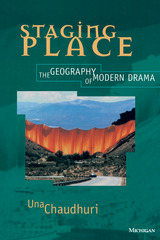 Staging Place: The Geography of Modern Drama
Una Chaudhuri
University of Michigan Press, 1997 Staging Place: The Geography of Modern Drama reimagines the content and continuities of theater history and exposes underlying dialogues between "home and homelessness, belonging and exile"--a century-long struggle with the meaning and power of place, which the author terms "geopathology." By reading canonical works in conjunction with contemporary ones, Chaudhuri charts the evolution of a dramatic paradigm with profound theatrical and thematic implications.
Chaudhuri starts with a discussion of a "poetics of exile" in early modern drama, where the figure of home is constructed as a locus of two conflicting impulses: the desire to find a stable site for individual identity and the desire to deterritorialize the self. By mid-century, she argues, a new discourse of "failed homecoming" begins to displace this geopathic model and replace the poetics of exile with a grim anti-poetics of immigration. She then employs postmodern and postcolonial theories of place and culture to define the emerging multiculturalism as a creative reworking of the figures of home, homecoming, homelessness, immigration and exile.
"This is a book of real originality. Its treatment of space in modern drama is elegant and powerful. . . ." --William B. Worthen, Northwestern University
"Staging Place is a powerfully written book, deft in its handling of familiar and unfamiliar plays alike and eclectic in its use of theatrical sources." --Essays in Theatre/ Études théâtrales
"This sophisticated and well-written study for graduate students and their teachers explores modern drama's preoccupation with the seemingly irreconcilable discontinuities between the notions of home and homelessness, belonging and exile. . . . The readings of individual plays are fresh and invigorating. . . ." --Choice
Una Chaudhuri is Associate Professor of English, New York University.
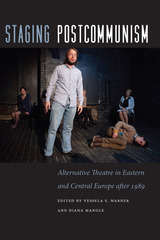 Staging Postcommunism: Alternative Theatre in Eastern and Central Europe after 1989
Vessela S. Warner and Diana Manole
University of Iowa Press, 2020 Theatre in Eastern and Central Europe was never the same after the fall of the Berlin Wall in 1989. In the transition to a postcommunist world, “alternative theatre” found ways to grapple with political chaos, corruption, and aggressive implementation of a market economy. Three decades later, this volume is the first comprehensive examination of alternative theatre in ten former communist countries. The essays focus on companies and artists that radically changed the language and organization of theatre in the countries formerly known as the Eastern European bloc. This collection investigates the ways in which postcommunist alternative theatre negotiated and embodied change not only locally but globally as well.
Contributors: Dennis Barnett, Dennis C. Beck, Violeta Decheva, Luule Epner, John Freedman, Barry Freeman, Margarita Kompelmakher, Jaak Rahesoo, Angelina Ros¸ca, Ban¸uta Rubess, Christopher Silsby, Andrea Tompa, S. E. Wilmer
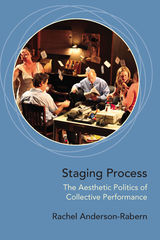 Staging Process: The Aesthetic Politics of Collective Performance
Rachel Anderson-Rabern
Northwestern University Press, 2020 Staging Process examines contemporary collective creation practices, with particular focus on the work of four third wave American performance ensembles: Goat Island, Elevator Repair Service, Nature Theater of Oklahoma, and the TEAM. The book examines ways in which these groups create blueprints for developing collaborative performance, entwining methodology with emerging performance aesthetics.
Rachel Anderson-Rabern explores the ideas of boredom and quotidian employment that permeate particular performance projects. Using Henri Lefebvre’s concepts of work roles within everyday philosophy, she demonstrates that collective creation gives rise to new economies of performance. The book also presents theories of the political stakes of danced gestural forms in performance, informed by Giorgio Agamben’s writings on gesture, and elaborates the ways in which these ensembles make use of durational performance to posit ethical frameworks: ways of living in the world.
Conversing with the ideas of Paul Virilio and Guy Debord among others, Anderson- Rabern claims that these groups posit new models of aesthetic politics through careful, speed-based investigations of construction and destruction that unearth the powerful potential of contemporary collaborative methods to be at once aesthetically minded, ethically driven, and politically engaged.
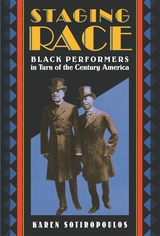 Staging Race: Black Performers in Turn of the Century America
Karen Sotiropoulos
Harvard University Press, 2006 Staging Race casts a spotlight on the generation of black artists who came of age between 1890 and World War I in an era of Jim Crow segregation and heightened racial tensions. As public entertainment expanded through vaudeville, minstrel shows, and world's fairs, black performers, like the stage duo of Bert Williams and George Walker, used the conventions of blackface to appear in front of, and appeal to, white audiences. At the same time, they communicated a leitmotif of black cultural humor and political comment to the black audiences segregated in balcony seats. With ingenuity and innovation, they enacted racial stereotypes onstage while hoping to unmask the fictions that upheld them offstage.
Drawing extensively on black newspapers and commentary of the period, Karen Sotiropoulos shows how black performers and composers participated in a politically charged debate about the role of the expressive arts in the struggle for equality. Despite the racial violence, disenfranchisement, and the segregation of virtually all public space, they used America's new businesses of popular entertainment as vehicles for their own creativity and as spheres for political engagement.
The story of how African Americans entered the stage door and transformed popular culture is a largely untold story. Although ultimately unable to erase racist stereotypes, these pioneering artists brought black music and dance into America's mainstream and helped to spur racial advancement.
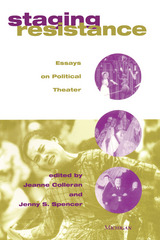 Staging Resistance: Essays on Political Theater
Jeanne Colleran and Jenny S. Spencer, Editors
University of Michigan Press, 1998 Staging Resistance interrogates political performance in a variety of cultural and national contexts. The book's essays examine work by artists ranging from the Bread and Puppet Theatre to Théatre du Soleil to Athol Fugard to lesser-known grassroots organizations across the globe. The contributors' broad survey of work, as varied as the contexts in which it occurs, indicates that older paradigms for the study of political theater may no longer be viable. As the essays show, a wide variety of theoretical approaches and political assumptions must be actively and self-consciously negotiated in order to make sense of the theater's relevance to the social sphere.
Focused studies of individual plays complement broad-based discussions of the place of theater in a radically democratic society. Staging Resistance is particularly strong in its concern with the intersection of gender and national politics; the collection specifically engages work by and about women in relation to broader geopolitical issues. Resisting the urge to be representative, the editors smartly highlight the divergent interests and concerns of authors who envision their work as an active form of cultural struggle. This consistently challenging collection of essays describes an art of change confronting the processes of change itself.
Jeanne Colleran is Associate Professor and Chair of the English Department, John Carroll University. Jenny S. Spencer is Associate Professor of English, University of Massachusetts, Amherst.
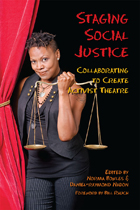 Staging Social Justice: Collaborating to Create Activist Theatre
Edited by Norma Bowles and Daniel-Raymond Nadon
Southern Illinois University Press, 2013
Normal.dotm0011901163SIU Press195141012.00false18 pt18 pt00falsefalsefalseFringe Benefits, an award-winning theatre company, collaborates with schools and communities to create plays that promote constructive dialogue about diversity and discrimination issues. Staging Social Justice is a groundbreaking collection of essays about Fringe Benefits’ script-devising methodology and their collaborations in the United States, Australia, Canada and the United Kingdom. The anthology also vividly describes the transformative impact of these creative initiatives on participants and audiences. By reflecting on their experiences working on these projects, the contributing writers—artists, activists and scholars—provide the readerwith tools and inspiration to create their own theatre for social change.
“Contributors to this big-hearted collection share Fringe Benefits’ play devising process, and a compelling array of methods for measuring impact, approaches to aesthetics (with humor high on the list), coalition and community building, reflections on safe space, and acknowledgement of the diverse roles needed to apply theatre to social justice goals. The book beautifully bears witness to both how generative Fringe Benefits’ collaborations have been for participants and to the potential of engaged art in multidisciplinary ecosystems more broadly.”—Jan Cohen-Cruz, editor of Public: A Journal of Imagining America
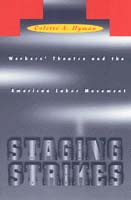 Staging Strikes: Workers' Theatre and the American Labor Movement
Collette Hyman
Temple University Press, 1997 In the thirties, those on the political left, Socialists, Communists, artists and writers, educators, and labor movement activists, shared the belief that leisure activities should reflect and promote the interests of working people. Cultural activities should be used to educate workers in bringing about radical social and political changes and to draw people together around shared interests. Workers' theater became a successful vehicle for political education and for involving the audience in the labor movement.
Such plays as "Let Freedom Ring" and "Waiting for Lefty" depicted experiences that paralleled the audiences' own, that entertained and absorbed them, and that showed them the personal, social, economic, and political changes that could be achieved through the struggles of the labor movement.
In clear and moving prose, Hyman traces the history of workers' theater from its grassroots origins to the Federal Theater Project of the WPA under Roosevelt and into unions' recreational programs. Even today, the tradition of workers' theater endures in local and regional productions that reflect current worker concerns or revive significant workers' plays of the Depression period. Hyman shows that the significance of workers' theater lies not only in the plays produced but also in the audiences' experience, in coming together out of common concerns to achieve a solidarity that emphasizes the effectiveness of collective action.
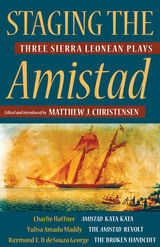 Staging the Amistad: Three Sierra Leonean Plays
Charlie Haffner
Ohio University Press, 2019 Staging the Amistad collects in print for the first time plays about the Amistad slave revolt by three of Sierra Leone’s most influential playwrights of the latter decades of the twentieth century: Charlie Haffner, Yulisa Amadu “Pat” Maddy, and Raymond E. D. de’Souza George. Until the late 1980s, when the first of these plays was performed, the 1839 shipboard slave rebellion and the return of its victors to their homes in what is modern-day Sierra Leone had been an unrecognized chapter in the country’s history. The plays recast the tale of heroism, survival, and resistance to tyranny as a distinctly Sierra Leonean story, emphasizing the agency of its African protagonists. For this reason, Haffner, Maddy, and de’Souza George counterbalance the better-known American representations of the rebellion, which center on American characters and American political and cultural concerns. The first public performances of these plays constituted a watershed moment. Written and staged immediately before and after the start of Sierra Leone’s decade-long conflict, they brought the Amistad rebellion to public consciousness. Furthermore, their turn to a uniquely Sierra Leonean history of heroic resistance to tyranny highlights the persistent faith in nation-state nationalism and the dreams of decolonization.
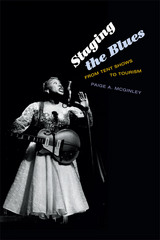 Staging the Blues: From Tent Shows to Tourism
Paige A. McGinley
Duke University Press, 2014 Singing was just one element of blues performance in the early twentieth century. Ma Rainey, Bessie Smith, and other classic blues singers also tapped, joked, and flaunted extravagant costumes on tent show and black vaudeville stages. The press even described these women as "actresses" long before they achieved worldwide fame for their musical recordings. In Staging the Blues, Paige A. McGinley shows that even though folklorists, record producers, and festival promoters set the theatricality of early blues aside in favor of notions of authenticity, it remained creatively vibrant throughout the twentieth century. Highlighting performances by Rainey, Smith, Lead Belly, Sister Rosetta Tharpe, Sonny Terry, and Brownie McGhee in small Mississippi towns, Harlem theaters, and the industrial British North, this pioneering study foregrounds virtuoso blues artists who used the conventions of the theater, including dance, comedy, and costume, to stage black mobility, to challenge narratives of racial authenticity, and to fight for racial and economic justice.
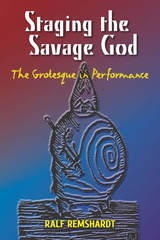 Staging the Savage God: The Grotesque in Performance
Ralf Remshardt
Southern Illinois University Press, 2004 In this broadly conceived study, Ralf Remshardt delineates the theatre’s deep connection with the grotesque and traces the historically extensive and theoretically intensive relationship between performance and its “other,” the grotesque. Staging the Savage God: The Grotesque in Performance examines the aesthetic complicity shared by the two in both art and theatre and presents a general theory of the grotesque.
Performing the grotesque is both a challenge to a culture’s order and the affirmation of certain ethical principles that it recognizes as its own. Remshardt investigates the aesthetics and ideology of grotesque theatre from antiquity—in works such as The Bacchae and Thyestes—to modernity—in Ubu Roi and Hamletmachine—and opens up new critical possibilities for the analysis of both classical and avant-gardetheatre.
Divided into three sections, Staging the Savage God first interrogates the grotesque as primarily a visual artistic and theatrical mode and then inventories various critical approaches to the grotesque, establishing the outlines of a theory with regard to drama. In the most extensive part of the study, Remshardt shifts his emphasis to the theatre of the grotesque, from self-consuming tragedies and the modernist trope of the artificial human figure to the characterology of the grotesque. Remshardt’s conclusion takes bold steps toward unraveling the paradox inherent in the grotesque theatre.
Written in an engaging style and aided by nine illustrations, Staging the Savage God is a comprehensive and rigorous study that incorporates critical approaches from disciplines such as philosophy, psychoanalysis, art history, literature, and theatre to fully investigate the historical function of the grotesque in performance.
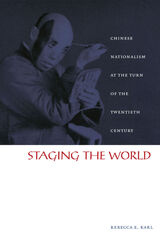 Staging the World: Chinese Nationalism at the Turn of the Twentieth Century
Rebecca E. Karl
Duke University Press, 2002 In Staging the World Rebecca E. Karl rethinks the production of nationalist discourse in China during the late Qing period, between China’s defeat in the Sino-Japanese War in 1895 and the proclamation of the Republic in 1911. She argues that at this historical moment a growing Chinese identification with what we now call the Third World first made the modern world visible as a totality and that the key components of Chinese nationalist discourse developed in reference to this worldview.
The emergence of Chinese nationalism during this period is often portrayed as following from China’s position vis-à-vis Japan and the West. Karl has mined the archives of the late Qing period to discern the foci of Chinese intellectuals from 1895 to 1911 to assert that even though the China/Japan/West triangle was crucial, it alone is an incomplete—and therefore flawed—model of the development of nationalism in China. Although the perceptions and concerns of these thinkers form the basis of Staging the World, Karl begins by examining a 1904 Shanghai production of an opera about a fictional partition of Poland and its modern reincarnation as an ethno-nation. By focusing on the type of dialogue this opera generated in China, Karl elucidates concepts such as race, colonization, globalization, and history. From there, she discusses how Chinese conceptions of nationalism were affected by the “discovery” of Hawai’i as a center of the Pacific, the Philippine revolution against the United States, and the relationship between nationality and ethnicity made apparent by the Boer War in South Africa.
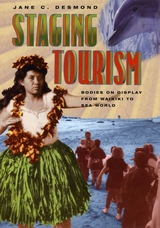 Staging Tourism: Bodies on Display from Waikiki to Sea World
Jane C. Desmond
University of Chicago Press, 1999 From Shamu the dancing whale at Sea World to Hawaiian lu'au shows, Staging Tourism analyzes issues of performance in a wide range of tourist venues. Jane C. Desmond argues that the public display of bodies—how they look, what they do, where they do it, who watches, and under what conditions—is profoundly important in structuring identity categories of race, gender, and cultural affiliation. These fantastic spectacles of corporeality form the basis of hugely profitable tourist industries, which in turn form crucial arenas of public culture where embodied notions of identity are sold, enacted, and debated.
Gathering together written accounts, postcards, photographs, advertisements, films, and oral histories as well as her own interpretations of these displays, Desmond gives us a vibrant account of U.S. tourism in Waikiki from 1900 to the present. She then juxtaposes cultural tourism with "animal tourism" in the United States, which takes place at zoos, aquariums, and animal theme parks. In each case, Desmond argues, the relationship between the viewer and the viewed is ultimately based on concepts of physical difference harking back to the nineteenth century.
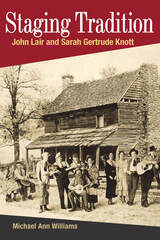 Staging Tradition: John Lair and Sarah Gertrude Knott
Michael Ann Williams
University of Illinois Press, 2006 Based on extensive archival research and oral history, Staging Tradition traces the parallel careers of the creators of the Renfro Valley Barn Dance and the National Folk Festival. Through their devotion to the staging of traditional culture, including folk, country, and bluegrass music, John Lair (1894-1985) and Sarah Gertrude Knott (1895-1984) became two of the mid-twentieth century's most notable producers. Lair and Knott's discovery of new developments in theater and entertainment during the 1920s led the pair to careers that kept each of them center stage. Inspired by programs such as WLS's Barn Dance and the success of early folk events, Lair promoted Kentucky musicians. Knott staged her own radically inclusive festival, which included Native and African American traditions and continues today as the National Folk Festival. Michael Ann Williams shows how Lair and Knott fed the public's fascination with the "art of the common man" and were in turn buffeted by cultural forces that developed around and beyond them.
 Staging Visitation: Tourist Performances and Theatricalized Places
Bryan Schmidt and Weston Twardowski
University of Michigan Press, 2026 Staging Visitation frames tourism and travel as complex social performances that shape identities, communities, and global imaginaries. This volume proposes “visitation” as a framework that emphasizes the participatory and relational dimensions of travel. While tourism is often pejoratively framed as a commodified or exploitative leisure activity for those with means, its reality is far more nuanced. Tourism stages heritage, provokes encounters across cultural divides, and prompts both visitors and hosts to negotiate values and identities—all while sustaining economies (and the power relations they produce) at global and local scales.
From museums and theme parks to festivals and influencer culture, the essays in this volume trace how transitory encounters—embodied, affective, and historically layered—build travel destinations into theatricalized places. These essays bring theatre and performance studies into conversation with cultural geography, sociology, anthropology, and media studies to demonstrate how tourism functions as both a stage and a repertoire for modern life.
Staging Visitation argues that travel is not only about movement across space, but also about the performance of culture itself—its preservation, reinvention, and transformation.
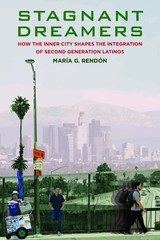 Stagnant Dreamers: How the Inner City Shapes the Integration of the Second Generation
Maria G. Rendon
Russell Sage Foundation, 2019 Winner of the 2020 Robert E. Park Award for Best Book from the Community and Urban Sociology Section of the American Sociological Association
Winner of the 2020 Distinguished Contribution to Research Award from the Latino/a Section of the American Sociological Association
Honorable Mention for the 2020 Thomas and Znaniecki Award from the International Migration Section of the American Sociological Association
A quarter of young adults in the U.S. today are the children of immigrants, and Latinos are the largest minority group. In Stagnant Dreamers, sociologist and social policy expert María Rendón follows 42 young men from two high-poverty Los Angeles neighborhoods as they transition into adulthood. Based on in-depth interviews and ethnographic observations with them and their immigrant parents, Stagnant Dreamers describes the challenges they face coming of age in the inner city and accessing higher education and good jobs, and demonstrates how family-based social ties and community institutions can serve as buffers against neighborhood violence, chronic poverty, incarceration, and other negative outcomes. Neighborhoods in East and South Central Los Angeles were sites of acute gang violence that peaked in the 1990s, shattering any romantic notions of American life held by the immigrant parents. Yet, Rendón finds that their children are generally optimistic about their life chances and determined to make good on their parents’ sacrifices. Most are strongly oriented towards work. But despite high rates of employment, most earn modest wages and rely on kinship networks for labor market connections. Those who made social connections outside of their family and neighborhood contexts, more often found higher quality jobs. However, a middle-class lifestyle remains elusive for most, even for college graduates. Rendón debunks fears of downward assimilation among second-generation Latinos, noting that most of her subjects were employed and many had gone on to college. She questions the ability of institutions of higher education to fully integrate low-income students of color. She shares the story of one Ivy League college graduate who finds himself working in the same low-wage jobs as his parents and peers who did not attend college. Ironically, students who leave their neighborhoods to pursue higher education are often the most exposed to racism, discrimination, and classism. Rendón demonstrates the importance of social supports in helping second-generation immigrant youth succeed. To further the integration of second-generation Latinos, she suggests investing in community organizations, combating criminalization of Latino youth, and fully integrating them into higher education institutions. Stagnant Dreamers presents a realistic yet hopeful account of how the Latino second generation is attempting to realize its vision of the American dream.
 Stagolee Shot Billy
Cecil Brown
Harvard University Press, 2004 Although his story has been told countless times--by performers from Ma Rainey, Cab Calloway, and the Isley Brothers to Ike and Tina Turner, James Brown, and Taj Mahal--no one seems to know who Stagolee really is. Stack Lee? Stagger Lee? He has gone by all these names in the ballad that has kept his exploits before us for over a century. Delving into a subculture of St. Louis known as "Deep Morgan," Cecil Brown emerges with the facts behind the legend to unfold the mystery of Stack Lee and the incident that led to murder in 1895.
How the legend grew is a story in itself, and Brown tracks it through variants of the song "Stack Lee"--from early ragtime versions of the '20s, to Mississippi John Hurt's rendition in the '30s, to John Lomax's 1940s prison versions, to interpretations by Lloyd Price, James Brown, and Wilson Pickett, right up to the hip-hop renderings of the '90s. Drawing upon the works of James Baldwin, Richard Wright, and Ralph Ellison, Brown describes the powerful influence of a legend bigger than literature, one whose transformation reflects changing views of black musical forms, and African Americans' altered attitudes toward black male identity, gender, and police brutality. This book takes you to the heart of America, into the soul and circumstances of a legend that has conveyed a painful and elusive truth about our culture.
 Stained Glass Ceilings: How Evangelicals Do Gender and Practice Power
Lisa Weaver Swartz
Rutgers University Press, 2023 Stained Glass Ceilings speaks to the intersection of gender and power within American evangelicalism by examining the formation of evangelical leaders in two seminary communities.Southern Baptist Theological Seminary inspires a vision of human flourishing through gender differentiation and male headship. Men practice “Godly Manhood," and are taught to act as the "head" of a family, while their wives are socialized into codes of “Godly Womanhood" that prioritize prescribed gender roles. This power structure privileges men yet offers agency to their wives in women-centered spaces and through marital relationships. Meanwhile, Asbury Theological Seminary promises freedom from gendered hierarchies. Appealing to a story of gender-blind equality, Asbury welcomes women into classrooms, administrative offices, and pulpits. But the institution’s construction of egalitarianism obscures the fact that women are rewarded for adapting to an existing male-centered status quo rather than for developing their own voices as women. Featuring high-profile evangelicals such as Al Mohler and Owen Strachan, along with young seminarians poised to lead the movement in the coming decades, Stained Glass Ceilings illustrates the liabilities of white evangelical toolkits and argues that evangelical culture upholds male-centered structures of power even as it facilitates meaning and identity.
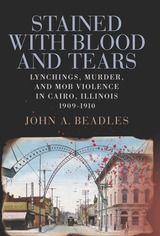 Stained with Blood and Tears: Lynchings, Murder, and Mob Violence in Cairo, Illinois, 1909-1910
John A. Beadles
Southern Illinois University Press, 2019 Packed with villains, victims, and heroes, Stained with Blood and Tears recounts the story of what has been called the “equal opportunity” lynchings of Will “Froggie” James, who was black, and Henry Salzner, a white man, in the rowdy river town of Cairo, Illinois, on November 11, 1909. This book is the first to focus on one of the most infamous nights of lynching in the history of the United States, when about one thousand men and women were transformed into a murderous mob. The book also details a lesser-known attempted lynching of a suspected purse snatcher by another mob about ninety days later. That mob was beaten back by about a dozen mostly African American deputies and a white sheriff. Stained with Blood and Tears ends with the saga of the killing of a Cairo policeman in the police station by the sheriff from a neighboring county over an incident that began in a Cairo brothel. The book thoroughly examines a dark side of Cairo’s past when it had a Jim Crow mind-set and crooked policemen and was awash in liquor and teeming with prostitutes and gambling houses. The violence of the era led the town’s Catholic priest to lament, “Must this fair city of ours go ever in garments spattered with blood?”
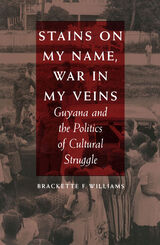 Stains on My Name, War in My Veins: Guyana and the Politics of Cultural Struggle
Brackette F. Williams
Duke University Press, 1991 Burdened with a heritage of both Spanish and British colonization and imperialism, Guyana is today caught between its colonial past, its efforts to achieve the consciousness of nationhood, and the need of its diverse subgroups to maintain their own identity. Stains on My Name, War in My Veins chronicles the complex struggles of the citizens of Guyana to form a unified national culture against the pulls of ethnic, religious, and class identities.
Drawing on oral histories and a close study of daily life in rural Guyana, Brackette E. Williams examines how and why individuals and groups in their quest for recognition as a “nation” reproduce ethnic chauvinism, racial stereotyping, and religious bigotry. By placing her ethnographic study in a broader historical context, the author develops a theoretical understanding of the relations among various dimensions of personal identity in the process of nation building.
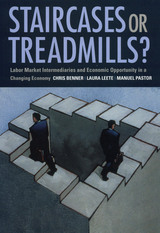 Staircases or Treadmills?: Labor Market Intermediaries and Economic Opportunity in a Changing Economy
Chris Benner
Russell Sage Foundation, 2007 Globalization, technological change, and deregulation have made the American marketplace increasingly competitive in recent decades, but for many workers this "new economy" has entailed heightened job insecurity, lower wages, and scarcer benefits. As the job market has grown more volatile, a variety of labor market intermediaries—organizations that help job seekers find employment—have sprung up, from private temporary agencies to government "One-Stop Career Centers." In Staircases or Treadmills? Chris Benner, Laura Leete, and Manuel Pastor investigate what approaches are most effective in helping workers to secure jobs with decent wages and benefits, and they provide specific policy recommendations for how job-matching organizations can better serve disadvantaged workers. Staircases or Treadmills? is the first comprehensive study documenting the prevalence of all types of labor market intermediaries and investigating how these intermediaries affect workers' employment opportunities. Benner, Leete, and Pastor draw on years of research in two distinct regional labor markets—"old economy" Milwaukee and "new economy" Silicon Valley—including a first-of-its-kind random survey of the prevalence and impacts of intermediaries, and a wide range of interviews with intermediary agencies' staff and clients. One of the main obstacles that disadvantaged workers face is that social networks of families and friends are less effective in connecting job-seekers to stable, quality employment. Intermediaries often serve as a substitute method for finding a job. Which substitute is chosen, however, matters: The authors find that the most effective organizations—including many unions, community colleges, and local non-profits—actively foster contacts between workers and employers, tend to make long-term investments in training for career development, and seek to transform as well as satisfy market demands. But without effective social networks to help workers locate the best intermediaries, most rely on private temporary agencies and other organizations that offer fewer services and, statistical analysis shows, often channel their participants into jobs with low wages and few benefits. Staircases or Treadmills? suggests that, to become more effective, intermediary organizations of all types need to focus more on training workers, teaching networking skills, and fostering contact between workers and employers in the same industries. A generation ago, rising living standards were broadly distributed and coupled with relatively secure employment. Today, many Americans fear that heightened job insecurity is overshadowing the benefits of dynamic economic growth. Staircases or Treadmills? is a stimulating guide to how private and public job-matching institutions can empower disadvantaged workers to share in economic progress.
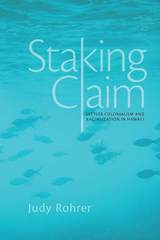 Staking Claim: Settler Colonialism and Racialization in Hawai'i
Judy Rohrer
University of Arizona Press, 2016 In the heart of the Pacific Ocean, Hawai‘i exists at a global crosscurrent of indigeneity and race, homeland and diaspora, nation and globalization, sovereignty and imperialism. In order to better understand how settler colonialism works and thus move decolonization efforts forward, Staking Claim analyzes competing claims of identity, belonging, and political status in Hawai‘i.
Author Judy Rohrer brings together an analysis of racial formation and colonization in the islands through a study of legal cases, contemporary public discourse (local media and literature), and Hawai‘i scholarship. Her analysis exposes how racialization works to obscure—with the ultimate goal of eliminating—native Hawaiian indigeneity, homeland, nation, and sovereignty.
Staking Claim argues that the dual settler colonial processes of racializing native Hawaiians (erasing their indigeneity), and indigenizing non-Hawaiians, enable the staking of non-Hawaiian claims to Hawai‘i. It encourages us to think beyond a settler-native binary by analyzing the ways racializations of Hawaiians and various non-Hawaiian settlers and arrivants bolster settler colonial claims, structures, and white supremacist ideologies.
 Staking Her Claim: Life Of Belinda Mulrooney
Melanie J. Mayer
Ohio University Press, 1999 If Horatio Alger had imagined a female heroine in the same mold as one of the young male heroes in his rags-to-riches stories, she would have looked like Belinda Mulrooney. Smart, ambitious, competitive, and courageous, Belinda Mulrooney was destined through her legendary pioneering in the wilds of the Yukon basin to found towns and many businesses. She built two fortunes, supported her family, was an ally to other working women, and triumphed in what was considered a man's world.
In Staking Her Claim, Melanie Mayer and Robert N. DeArmond provide a faithful and comprehensive portrait of this unique character in North American frontier history. Their exhaustive research has resulted in a sweeping saga of determination and will, tempered by disaster and opportunity.
Like any good Horatio Alger hero, Belinda overcame the challenges that confronted her, including poverty, prejudice, a lack of schooling, and the early loss of parents. Her travels took her from her native Ireland as a young girl to a coal town in Pennsylvania to Chicago, San Francisco, and finally, in 1897, to the Yukon.
Staking Her Claim is a testament to the human spirit and to the idea of the frontier. It is a biography of a woman who made her own way in the world and in doing so left an indelible mark.
 Staking Her Claim: Life Of Belinda Mulrooney
Melanie J. Mayer
Ohio University Press, 1999 If Horatio Alger had imagined a female heroine in the same mold as one of the young male heroes in his rags-to-riches stories, she would have looked like Belinda Mulrooney. Smart, ambitious, competitive, and courageous, Belinda Mulrooney was destined through her legendary pioneering in the wilds of the Yukon basin to found towns and many businesses. She built two fortunes, supported her family, was an ally to other working women, and triumphed in what was considered a man's world.
In Staking Her Claim, Melanie Mayer and Robert N. DeArmond provide a faithful and comprehensive portrait of this unique character in North American frontier history. Their exhaustive research has resulted in a sweeping saga of determination and will, tempered by disaster and opportunity.
Like any good Horatio Alger hero, Belinda overcame the challenges that confronted her, including poverty, prejudice, a lack of schooling, and the early loss of parents. Her travels took her from her native Ireland as a young girl to a coal town in Pennsylvania to Chicago, San Francisco, and finally, in 1897, to the Yukon.
Staking Her Claim is a testament to the human spirit and to the idea of the frontier. It is a biography of a woman who made her own way in the world and in doing so left an indelible mark.
Staley: The Fight for a New American Labor Movement
Steven K. Ashby and C. J. Hawking
University of Illinois Press, 2008 This on-the-ground labor history chronicles the bitterly contested labor conflict in the mid 1990s at the A. E. Staley corn processing plant in Decatur, Illinois, where workers waged one of the most hard-fought struggles in recent labor history. When the company launched a full-scale assault on its workers, Allied Industrial Workers Local 837 responded by educating and mobilizing its members, organizing strong support from the religious and African American communities, building a nationwide solidarity movement, and engaging in nonviolent civil disobedience at the plant gates. Through scores of interviews and videotapes of every union meeting, the authors bring the workers' voices to the fore and reveal their innovative tactics that inform and strengthen today's labor movement.
 Stalin: A Biography
Robert Service
Harvard University Press, 2005 Overthrowing the conventional image of Stalin as an uneducated political administrator inexplicably transformed into a pathological killer, Robert Service reveals a more complex and fascinating story behind this notorious twentieth-century figure. Drawing on unexplored archives and personal testimonies gathered from across Russia and Georgia, this is the first full-scale biography of the Soviet dictator in twenty years.
Service describes in unprecedented detail the first half of Stalin's life--his childhood in Georgia as the son of a violent, drunkard father and a devoted mother; his education and religious training; and his political activity as a young revolutionary. No mere messenger for Lenin, Stalin was a prominent activist long before the Russian Revolution. Equally compelling is the depiction of Stalin as Soviet leader. Service recasts the image of Stalin as unimpeded despot; his control was not limitless. And his conviction that enemies surrounded him was not entirely unfounded.
Stalin was not just a vengeful dictator but also a man fascinated by ideas and a voracious reader of Marxist doctrine and Russian and Georgian literature as well as an internationalist committed to seeing Russia assume a powerful role on the world stage. In examining the multidimensional legacy of Stalin, Service helps explain why later would-be reformers--such as Khrushchev and Gorbachev--found the Stalinist legacy surprisingly hard to dislodge.
Rather than diminishing the horrors of Stalinism, this is an account all the more disturbing for presenting a believable human portrait. Service's lifetime engagement with Soviet Russia has resulted in the most comprehensive and compelling portrayal of Stalin to date.
Stalin: An Unknown Portrait
Miklós Kun
Central European University Press, 2003 This exceptional volume contains exciting new information about Stalin's actual and political "family", the Kremlin Mafia and the clans around him. The author has interviewed key politicians who survived the Stalin era, including officials of the KGB and the Party, as well as people who had personal contact with the dictator as secretaries or interpreters. Kun's special expertise and his access to archival sources in Russia have resulted in a work revealing jealously guarded secrets. In addition to the interviews and hitherto unpublished correspondence between Stalin, Molotov, Voroshilov, Mikoyan, Zhdanov and others, the book also contains a fascinating collection of over 300 photos of Stalin, his family members, and various political actors of the period. Extensive notes, a bibliography, and an index of names add to the value of the volume.
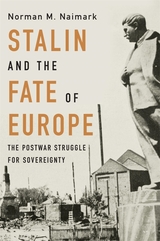 Stalin and the Fate of Europe: The Postwar Struggle for Sovereignty
Norman M. Naimark
Harvard University Press, 2019 Winner of the Norris and Carol Hundley Award
Winner of the U.S.–Russia Relations Book Prize
A Financial Times Best History Book of the Year
The Cold War division of Europe was not inevitable—the acclaimed author of Stalin’s Genocides shows how postwar Europeans fought to determine their own destinies.
Was the division of Europe after World War II inevitable? In this powerful reassessment of the postwar order in Europe, Norman Naimark suggests that Joseph Stalin was far more open to a settlement on the continent than we have thought. Through revealing case studies from Poland and Yugoslavia to Denmark and Albania, Naimark recasts the early Cold War by focusing on Europeans’ fight to determine their future.
As nations devastated by war began rebuilding, Soviet intentions loomed large. Stalin’s armies controlled most of the eastern half of the continent, and in France and Italy, communist parties were serious political forces. Yet Naimark reveals a surprisingly flexible Stalin, who initially had no intention of dividing Europe. During a window of opportunity from 1945 to 1948, leaders across the political spectrum, including Juho Kusti Paasikivi of Finland, Wladyslaw Gomulka of Poland, and Karl Renner of Austria, pushed back against outside pressures. For some, this meant struggling against Soviet dominance. For others, it meant enlisting the Americans to support their aims.
The first frost of Cold War could be felt in the tense patrolling of zones of occupation in Germany, but not until 1948, with the coup in Czechoslovakia and the Berlin Blockade, did the familiar polarization set in. The split did not become irreversible until the formal division of Germany and establishment of NATO in 1949. In illuminating how European leaders deftly managed national interests in the face of dominating powers, Stalin and the Fate of Europe reveals the real potential of an alternative trajectory for the continent.
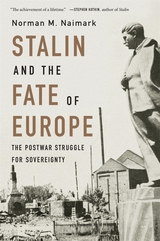 Stalin and the Fate of Europe: The Postwar Struggle for Sovereignty
Norman M. Naimark
Harvard University Press A Financial Times Best Book of the Year
Winner of the Norris and Carol Hundley Award
Winner of the US–Russia Relations Book Prize
“The achievement of a lifetime.”
—Stephen Kotkin, author of Stalin
“Naimark has few peers as a scholar of Stalinism, the Soviet Union and 20th-century Europe, and his latest work Stalin and the Fate of Europe is one of his most original and interesting.”
—Financial Times
“A timely and instructive account not merely of our own history but also of our fractious, unsettling present.”
—Daniel Beer, The Guardian
“Adds an abundance of fresh knowledge to a time and place that we think we know, clarifying the contours of Soviet–American conflict by skillfully enriching the history of postwar Europe.”
—Timothy Snyder, author of Bloodlands
Was the division of Europe after World War II inevitable? In this powerful reassessment of the postwar order, Norman Naimark suggests that Stalin was far more open to a settlement than we have thought. Through revealing case studies from Poland and Yugoslavia to Finland and Albania, Naimark recasts the early Cold War by focusing on Europeans’ fight to determine their future.
With Western occupation forces in central Europe and Soviet forces controlling most of the continent’s eastern half, European leaders had to nimbly negotiate outside pressures. For some, this meant repelling Soviet dominance. For others, it meant enlisting the Americans to support their aims. Revealing an at times surprisingly flexible Stalin and showing European leaders deftly managing their nations’ interests, Stalin and the Fate of Europe uncovers the lost potential of an alternative trajectory before 1949, when the Cold War split became irreversible.
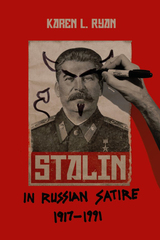 Stalin in Russian Satire, 1917–1991
Karen L. Ryan
University of Wisconsin Press, 2009 During Stalin’s lifetime the crimes of his regime were literally unspeakable. More than fifty years after his death, Russia is still coming to terms with Stalinism and the people’s own role in the abuses of the era. During the decades of official silence that preceded the advent of glasnost, Russian writers raised troubling questions about guilt, responsibility, and the possibility of absolution. Through the subtle vehicle of satire, they explored the roots and legacy of Stalinism in forms ranging from humorous mockery to vitriolic diatribe.
Examining works from the 1917 Revolution to the fall of the Soviet Union in 1991, Karen L. Ryan reveals how satirical treatments of Stalin often emphasize his otherness, distancing him from Russian culture. Some satirists portray Stalin as a madman. Others show him as feminized, animal-like, monstrous, or diabolical. Stalin has also appeared as the unquiet dead, a spirit that keeps returning to haunt the collective memory of the nation. While many writers seem anxious to exorcise Stalin from the body politic, for others he illuminates the self in disturbing ways. To what degree Stalin was and is “in us” is a central question of all these works. Although less visible than public trials, policy shifts, or statements of apology, Russian satire has subtly yet insistently participated in the protracted process of de-Stalinization.
 Stalinism Revisited: The Establishment of Communist Regimes in East-Central Europe
Vladimir Tismaneanu
Central European University Press, 2010 Deals with the period of takeover and of ‘high Stalinism’ in Eastern Europe (1945–1955). These years are considered to be fundamentally characterized by institutional and ideological transfers based upon the premise of radical transformism and of cultural revolution. Both a balance-sheet and a politico-historical synthesis that reflects the archival and thematic novelties which came about in the field of communism studies after 1989. Contains contributions analyzing various aspects related these topics for each country of the former Soviet bloc (with the exception of Albania). The essays are based on new archival research, some are reassessments of the author’s previous research and others are critical appraisals of the specific literature published on issues related to the main topic. A path-breaking comparative framework for interpreting the relationship between late Stalinism and the communist takeovers in former Eastern Europe. A bonus for the volume is that it also provides detailed, sectorial analyses for the Romanian case, something that the field paritcularly lacks.
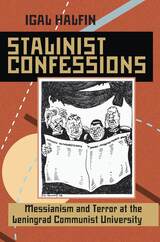 Stalinist Confessions: Messianism and Terror at the Leningrad Communist University
Igal Halfin
University of Pittsburgh Press, 2009
During Stalin's Great Terror, accusations of treason struck fear in the hearts of Soviet citizens-and lengthy imprisonment or firing squads often followed. Many of the accused sealed their fates by agreeing to confessions after torture or interrogation by the NKVD. Some, however, gave up without a fight.
In Stalinist Confessions, Igal Halfin investigates the phenomenon of a mass surrender to the will of the state. He deciphers the skillfully rendered discourse through which Stalin defined his cult of personality and consolidated his power by building a grassroots base of support and instilling a collective psyche in every citizen. By rooting out evil (opposition) wherever it hid, good communists could realize purity, morality, and their place in the greatest society in history. Confessing to trumped-up charges, comrades made willing sacrifices to their belief in socialism and the necessity of finding and making examples of its enemies.
Halfin focuses his study on Leningrad Communist University as a microcosm of Soviet society. Here, eager students proved their loyalty to the new socialism by uncovering opposition within the University. Through their meetings and self-reports, students sought to become Stalin's New Man.
Using his exhaustive research in Soviet archives including NKVD records, party materials, student and instructor journals, letters, and newspapers, Halfin examines the transformation in the language of Stalinist socialism. From an initial attitude that dismissed dissent as an error in judgment and redeemable through contrition to a doctrine where members of the opposition became innately wicked and their reform impossible, Stalin's socialism now defined loyalty in strictly black and white terms. Collusion or allegiance (real or contrived, now or in the past) with “enemies of the people” (Trotsky, Zinoviev, Bukharin, Germans, capitalists) was unforgivable. The party now took to the task of purging itself with ever-increasing zeal.
 Stalin's Italian Prisoners of War
Maria Teresa Giusti
Central European University Press, 2021 This book reconstructs the fate of Italian prisoners of war captured by the Red Army between August 1941 and the winter of 1942-43. On 230.000 Italians left on the Eastern front almost 100.000 did not come back home. Testimonies and memoirs from surviving veterans complement the author's intensive work in Russian and Italian archives. The study examines Italian war crimes against the Soviet civilian population and describes the particularly grim fate of the thousands of Italian military internees who after the 8 September 1943 Armistice had been sent to Germany and were subsequently captured by the Soviet army to be deported to the USSR. The book presents everyday life and death in the Soviet prisoner camps and explains the particularly high mortality among Italian prisoners. Giusti explores how well the system of prisoner labor, personally supervised by Stalin, was planned, starting in 1943. A special focus of the study is antifascist propaganda among prisoners and the infiltration of the Soviet security agencies in the camps. Stalin was keen to create a new cohort of supporters through the mass political reeducation of war prisoners, especially middle-class intellectuals and military élite. The book ends with the laborious diplomatic talks in 1946 and 1947 between USSR, Italy, and the Holy See for the repatriation of the surviving prisoners.
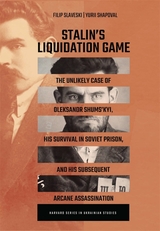 Stalin’s Liquidation Game: The Unlikely Case of Oleksandr Shums'kyi, His Survival in Soviet Prison, and His Subsequent Arcane Assassination
Filip Slaveski and Yuri Shapoval
Harvard University Press, 2025 Millions of innocent people were arrested in Stalin’s Soviet Union during the 1930s in different waves of mass repression. Under violent interrogation, many were forced to confess to crimes they did not commit. Rather than save their lives, as the interrogators had promised, confession was usually the last step to their execution. Very few of those arrested eventually refused to confess.
Oleksandr Shums’kyi, the Ukrainian Marxist revolutionary, was one of the most important but least known of them. He not only refused to confess but sustained for over a decade a massive protest against his repression and the Stalinist attack on his country, Ukraine. Stalin punished him mercilessly in response, paralyzing him in jail and murdering his wife, but refrained from assassinating him for more than ten years.
This book unravels the Shums’kyi riddle to explain why. In doing so, it opens a new window into understanding the history of Soviet repression and the Russian pathologies toward Ukrainian independence, which help us understand Russia’s current war against Ukraine.
 Stalin's Nomads: Power and Famine in Kazakhstan
Robert Kindler and Cynthia Klohr
University of Pittsburgh Press, 2018 Robert Kindler's seminal work is a comprehensive and unsettling account of the Soviet campaign to forcefully sedentarize and collectivize the Kazakh clans. Viewing the nomadic life as unproductive, and their lands unused and untilled, Stalin and his inner circle pursued a campaign of violence and subjugation, rather than attempting any dialog or cultural assimilation. The results were catastrophic, as the conflict and an ensuing famine (1931-1933) caused the death of nearly one-third of the Kazakh population. Hundreds of thousands of nomads became refugees and a nomadic culture and social order were essentially destroyed in less than five years.
Kindler provides an in-depth analysis of Soviet rule, economic and political motivations, and the role of remote and local Soviet officials and Kazakhs during the crisis. This is the first English-language translation of an important and harrowing history, largely unknown to Western audiences prior to Kindler’s study.
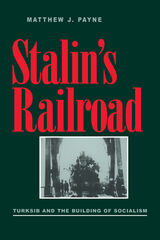 Stalin's Railroad: Turksib and the Building of Socialism
Matthew J. Payne
University of Pittsburgh Press, 2001 The Turkestano-Siberian Railroad, or Turksib, was one of the great construction projects of the Soviet Union’s First Five-Year Plan. As the major icon to ending the economic "backwardness" of the USSR’s minority republics, it stood apart from similar efforts as one of the most potent metaphors for the creation of a unified socialist nation.
Built between December 1926 and January 1931 by nearly 50,000 workers and at a cost of more 161 million rubles, Turksib embodied the Bolsheviks’ commitment to end ethnic inequality and promote cultural revolution in one the far-flung corners of the old Tsarist Empire, Kazakhstan. Trumpeted as the "forge of the Kazakh proletariat," the railroad was to create a native working class, bringing not only trains to the steppes, but also the Revolution.
In the first in-depth study of this grand project, Matthew Payne explores the transformation of its builders in Turksib’s crucible of class war, race riots, state purges, and the brutal struggle of everyday life. In the battle for the souls of the nation’s engineers, as well as the racial and ethnic conflicts that swirled, far from Moscow, around Stalin’s vast campaign of industrialization, he finds a microcosm of the early Soviet Union.
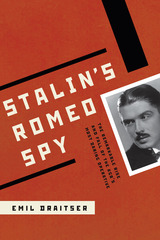 Stalin's Romeo Spy: The Remarkable Rise and Fall of the KGB's Most Daring Operative
Emil Draitser
Northwestern University Press, 2010 Sailor, painter, doctor, lawyer, polyglot, and writer, Dmitri Bystrolyotov (1901–75) led a life that might seem far-fetched for a spy novel, yet here the truth is stranger than fiction. The result of a thirty-five-year journey that started with a private meeting between the author and Bystrolyotov in 1973 Moscow and continued through the author’s subsequent research in international archives, Stalin’s Romeo Spy: The Remarkable Rise and Fall of the KGB’s Most Daring Operative pieces together a life lived in the shadows of the twentieth century’s biggest events. One of the “Great Illegals,” a team of outstanding Soviet spies operating in Western countries between the world wars, Bystrolyotov was mthe response to Sidney Reilly, the British prototype for James Bond. A dashing man, his modus operandi was the seduction of women—among them a French embassy employee, a German countess, the wife of a British official, and a Gestapo officer—which enabled Stalin to look into diplomatic pouches of many European countries. Risking his life, Bystrolyotov also stole military secrets from Nazi Germany and Fascist Italy. A man of extraordinary physical courage, he twice crossed the Sahara Desert and the jungles of Congo. But his success as a spy didn’t save him from Stalin’s purges, at the height of which he was arrested and tortured until he falsely confessed to selling out to the enemy. Sentenced to twenty years of hard labor in the Gulag, Bystrolyotov risked more severe punishment by documenting the regime’s crimes against humanity in unpublished and suppressed memoirs that rival those of Aleksandr Solzhenitsyn. The first full-length biography in any language, at once a real-life spy thriller, a drama of desire, and a prison memoir, Stalin’s Romeo Spy is the true account of a flawed yet extraordinary man.
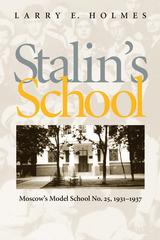 Stalin’s School: Moscow’s Model School No. 25, 1931–1937
Larry E. Holmes
University of Pittsburgh Press, 1999 A different kind of history, Stalin’s School brings a unique human dimension to the Soviet Union of the 1930s and a new understanding of Stalinism as a cultural and psychological phenomenon.
From 1931 to 1937, School No. 25 was the most famous and most lavishly appointed school in the Soviet Union—instructing the children of such prominent parents as Joseph Stalin, head of the Communist Party, Viacheslav Molotov, head of the Soviet State, and Paul Robeson, American actor and singer. Relying on published records, materials in eleven archives, accounts left by visiting foreigners—including the prominent American educator George Counts—and thirty six interviews with surviving pupils from the 1930s, Holmes brings the school to life. The school's administrators, teachers, pupils, friends, and foes become companions as well as objects of this study as we walk the schools halls, enter its classrooms, eavesdrop on feuding officials who debate its fate, and learn something of what the school and the period meant for its youth. Photographs of the school's teachers and students, and reproductions of the students' notebooks, drawings, and watercolors add personality to this compelling story.
Holmes uses the experience of School No. 25 as a microcosm and mirror of Stalinism, illuminating the interplay of state and society in decision making, and providing an opportunity to examine Stalinism from ideological, cultural, and psychological perspectives. While placing the school's history in the context of the coercion, corruption and repression of the 1930s, Holmes challenges the prevailing view that state and public spectacle on the one hand, and society and private life, on the other, were contrasting entities. School No. 25 molded these elements into an organic whole. In the intimate setting of Stalin's School, the degree of acceptance of Stalinism transcends historians' customary reference to the fear or privilege a Soviet citizen experienced. In a mutually reinforcing way, forced compliance and voluntary choice moved individual teachers and pupils to accept a structured environment both at school and in society as the means to a powerful, prosperous, and just Soviet Union.
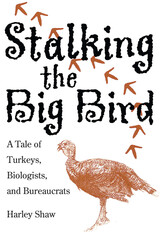 Stalking the Big Bird: A Tale of Turkeys, Biologists, and Bureaucrats
Harley Shaw
University of Arizona Press, 2004 Merriam's turkey is a bird native to the southern Rocky Mountains and the Colorado Plateau, a subspecies that might seem at first blush an unlikely subject for intensive research. But as Harley Shaw well knows, no creature is exempt from the close scrutiny of biologists. Shaw is himself a research biologist perhaps best known for his book Soul among Lions. Although the wild turkey may be less charismatic than the puma, it offers an equal opportunity for Shaw to reflect on how we manage—or mismanage—wildlife. But while focusing on this big bird of the Southwest, his new book is really a field study of another rare species, the wildlife management professional. Stalking the Big Bird is a sober and seasoned view of what that rare breed is doing, and failing to do, in its efforts to protect the animals and landscapes that we love.
State and federal wildlife agencies have for some sixty years functioned under the belief that increased knowledge produced by research improves our ability to manage wildlife. Shaw suggests that the more we know about a species, the more difficult clear decisions may often become. He offers shrewd observations on the difficulties of interpreting and implementing research results in the face of pressures exerted by government bureaucracies, non-governmental organizations, and politically powerful loggers, ranchers, land developers, and environmentalists. He also shows that management of even a common game bird may be beyond the capabilities of responsible resource management agencies. Through stories about his own experiences studying Merriam's wild turkey—anecdotes about the foibles of field work and the bureaucratic boondoggles of wildlife management—Shaw reveals some of the complexities involved in wildlife research.
Drawing on a lifetime of work and reflection, his book shows that sound research and effective management of this animal—and, by extension, others—are severely hampered by political agendas, social misunderstandings, inappropriate research, and above all, human indifference. As entertaining as it is informative, Stalking the Big Bird will be of interest to environmentalists, hunters, and resource managers—or anyone confused by the practices of modern wildlife conservation. It will help both professionals and lay readers understand our relationship with one wild subspecies, and in the process get a better handle on the true goals in managing the wild.
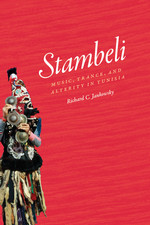 Stambeli: Music, Trance, and Alterity in Tunisia
Richard C. Jankowsky
University of Chicago Press, 2010 In Stambeli, Richard C. Jankowsky presents a vivid ethnographic account of the healing trance music created by the descendants of sub-Saharan slaves brought to Tunisia during the eighteenth and nineteenth centuries. Stambeli music calls upon an elaborate pantheon of sub-Saharan spirits and North African Muslim saints to heal humans through ritualized trance. Based on nearly two years of participation in the musical, ritual, and social worlds of stambeli musicians, Jankowsky’s study explores the way the music evokes the cross-cultural, migratory past of its originators and their encounters with the Arab-Islamic world in which they found themselves. Stambeli, Jankowsky avers, is thoroughly marked by a sense of otherness—the healing spirits, the founding musicians, and the instruments mostly come from outside Tunisia—which creates a unique space for profoundly meaningful interactions between sub-Saharan and North African people, beliefs, histories, and aesthetics.
Part ethnography, part history of the complex relationship between Tunisia’s Arab and sub-Saharan populations, Stambeli will be welcomed by scholars and students of ethnomusicology, anthropology, African studies, and religion.
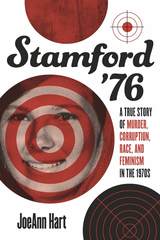 Stamford '76: A True Story of Murder, Corruption, Race, and Feminism in the 1970s
JoeAnn Hart
University of Iowa Press, 2019 In July 1976, a twenty-four-year-old white woman, Margo Olson, was found in a shallow grave in Stamford, Connecticut, with an arrow piercing through her heart. A few weeks later, Howie Carter, her black boyfriend, was killed by the police. Howie and Margo’s interracial relationship held a distorted mirror to the author’s own, with Howie’s best friend, Joe. Joe’s theory was that the police didn’t have any evidence to arrest Howie; operating on the assumption that the black man is always guilty, they killed him instead. Margo’s murder was never solved.
Looking back at what might have happened in 1976, the author discovers a Bicentennial year steeped in recession, racism, and unrelenting violence. It was also a time of flourishing second-wave feminism, when young women were encouraged to do anything, if only they knew how. Stamford was in the midst of urban renewal, destroying historically black neighborhoods to create space for corporations escaping a bankrupt and dangerous New York City, just forty miles away. Organized crime followed the money, infiltrating Stamford at all levels. The author reveals how racism, misogyny, the economy, and corruption affected the young people’s daily lives, and helped lead Margo and Howie to their deaths.
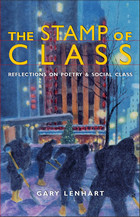 The Stamp of Class: Reflections on Poetry and Social Class
Gary Lenhart
University of Michigan Press, 2005 "The Stamp of Class addresses an important area that has not received sufficient attention. Lenhart directly confronts and deeply analyzes these questions while offering readers his clear, informative discussion."
-Lorenzo Thomas
The Stamp of Class explores the nature of reading poetry in the context of class and its themes and sheds new light on how this important yet little-heralded subject affects the poet's life and work.
While numerous works have taken up the question of race and gender as they relate to literary creation, this is the first book of its kind to probe the interplay between class and American poetry. Author Gary Lenhart considers poetry and class across a wide variety of time periods and poetic trends and reflects on a range of influential poets from the eighteenth to the twenty-first centuries.
The essays in The Stamp of Class deal with the question of class as reflected in the works of Tracie Morris, Tillie Olsen, Melvin Tolson, William Carlos Williams, Walt Whitman, and others. The work is rooted in the author's own experiences as a working-class poet and teacher and is the result of more than a decade of exploration.
Poet and scholar Gary Lenhart is Lecturer in English at Dartmouth College in Hanover, New Hampshire. His most recent books of poetry are Father and Son Night, Light Heart, and One at a Time. His essays and reviews have appeared in numerous magazines and journals, including the American Poetry Review, American Book Review, and Exquisite Corpse.
Stamped and Inscribed Objects from Seleucia on the Tigris
Robert Harbold McDowell
University of Michigan Press, 1935 Stamped and Inscribed Objects from Seleucia on the Tigris features materials excavated at Seleucia-on-the-Tigris in the 1927–32 excavations under the auspices of the University of Michigan, the Toledo Museum of Art, and the Cleveland Museum of Art. This volume presents excavations of an upper-class house and residential area near the Tigris.
 Stampede To Timberline: Ghost Towns & Mining
Muriel Sibell Wolle
Ohio University Press, 1974 This book includes the story of 240 of Colorado’s mining camps, with emphasis on the human side. The men who swarmed to the mountains to find precious metal came in successive waves from the late 1850s on, combing the gulches, scrambling over the passes and climbing the peaks. Their story is full of adventurous chances, lucky strikes, boom conditions, reckless spending, banditry, claim jumping, railroad wars and labor troubles.
The author searched the Colorado Rockies from the time she saw and sketched her first ghost town until she had rediscovered and painted the vanishing mining camps. Twenty-two maps give the location of each one and serve as a guide for those who want to reach them by car or jeep, by horseback or on foot.
The hardships of the early prospectors, the strikes they made, the gold and silver mines they uncovered, the towns they established, and the rise and fall of their fortunes are vividly recorded.
Names and dates are given of the earliest finds, of the most important mines and the money they made, of the newspapers printed, and of the hotels, churches and theaters erected. The difficult supply routes into the rocky fastnesses are also clearly traced. But all these facts are humanized by an author who is an artist rather than a historian, and to whom all this mining in the Colorado Rockies is essentially the story of heroic pioneer effort—the men and women behind the deeds.
The book contains 212 separate sketches made by the artist-author on the spot at the oftentimes remote and completely deserted mining camps. These pictures, as well as her 1200 other lithographic sketches of Colorado towns, form an invaluable record of places which are rapidly disappearing under the ravages of fire, wind and snow.
 Stamping American Memory: Collectors, Citizens, and the Post
Sheila A. Brennan
University of Michigan Press, 2018 Winner of the University of Michigan Press / Humanities, Arts, Science, and Technology Alliance and Collaboratory (HASTAC) Prize for Notable Work in the Digital Humanities
In the age of digital communications, it can be difficult to imagine a time when the meaning and imagery of stamps was politically volatile. While millions of Americans collected stamps from the 1880s to the 1940s, Stamping American Memory is the first scholarly examination of stamp collecting culture and how stamps enabled citizens to engage their federal government in conversations about national life in early-twentieth-century America. By examining the civic conversations that emerged around stamp subjects and imagery, this work brings to light the role that these underexamined historical artifacts have played in carrying political messages.
Sheila A. Brennan crafts a fresh synthesis that explores how the US postal service shaped Americans’ concepts of national belonging, citizenship, and race through its commemorative stamp program. Designed to be saved as souvenirs, commemoratives circulated widely and stood as miniature memorials to carefully selected snapshots from the American past that also served the political needs of small interest groups. Stamping American Memory brings together the histories of the US postal service and the federal government, collecting, and philately through the lenses of material culture and memory to make a significant contribution to our understanding of this period in American history.
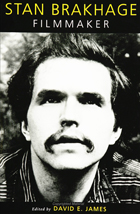 Stan Brakhage: Filmmaker
David James
Temple University Press, 2005 Stan Brakhage: Filmmaker is a collection of essays, photographs, personal statements, and reminiscences about the celebrated avant-garde filmmaker who died in 2003. The director of nearly four hundred short films, including Dog Star Man, Parts I-IV, and the Roman Numeral Series, Brakhage is widely recognized as one of the great artists of the medium. His shorts eschewed traditional narrative structure, and his innovations in fast cutting, hand-held camerawork, and multiple superimpositions created an unprecedentedly rich texture of images that provided the vocabulary for the explosion of independent filmmaking in the 1960s. Stan Brakhage: Filmmaker chronicles both the director's personal and formal development. The essays in this book—by historians, filmmakers, and other artists—assess Brakhage's contributions to the aesthetic and political history of filmmaking, from his emergence on the film scene and the establishment of his reputation, to the early-1980s. The result is a remarkable tribute to this lyrical, visionary artist.
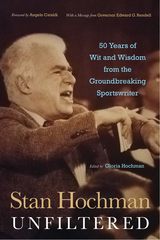 Stan Hochman Unfiltered: 50 Years of Wit and Wisdom from the Groundbreaking Sportswriter
Gloria Hochman
Temple University Press, 2020 The late Philadelphia Daily News sportswriter Stan Hochman was known for his many zingers, such as “Harry Litwack, the stoic Temple coach, stalks the sidelines like a blind man at a nudist colony.” As a reporter, he was more interested in how athletes felt, what their values were, how they lived their lives, or what made them tick than he was about how many runs they scored or punches they landed. In Stan Hochman Unfiltered, his wife Gloria collects nearly 100 of his best columns from the Daily News about baseball, horse racing, boxing, football, hockey, and basketball (both college and pro), as well as food, films, and even Liz Taylor. Each section is introduced by a friend or colleague, including Garry Maddox, Bernie Parent, Larry Merchant, and Ray Didinger, among others. Hochman penned a candid, cantankerous column about whether Pete Rose belongs in the Baseball Hall of Fame; wrote a graphic account of the Muhammad Ali and Joe Frazier fight of the century; and skewered Norman “Bottom Line” Braman, the one-time owner of the Eagles. He also wrote human-interest stories, including features about the importance of kids with special needs playing sports. In addition to being a beloved writer, Hochman was also known for his stint on WIP’s radio as the Grand Imperial Poobah, where he would settle callers’ most pressing debates. Hochman long earned the respect and admiration of his subjects, peers, and readers throughout his career, and Stan Hochman Unfiltered is a testament to his enduring legacy.
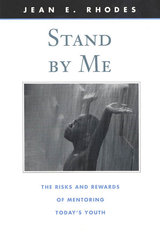 Stand by Me: The Risks and Rewards of Mentoring Today’s Youth
Jean E. Rhodes
Harvard University Press, 2004 A child at loose ends needs help, and someone steps in--a Big Brother, a Big Sister, a mentor from the growing ranks of volunteers offering their time and guidance to more than two million American adolescents. Does it help? How effective are mentoring programs, and how do they work? Are there pitfalls, and if so, what are they? Such questions, ever more pressing as youth mentoring initiatives expand their reach at a breakneck pace, have occupied Jean Rhodes for more than a decade. In this provocative, thoroughly researched, and lucidly written book, Rhodes offers readers the benefit of the latest findings in this burgeoning field, including those from her own extensive, groundbreaking studies.
Outlining a model of youth mentoring that will prove invaluable to the many administrators, caseworkers, volunteers, and researchers who seek reliable information and practical guidance, Stand by Me describes the extraordinary potential that exists in such relationships, and discloses the ways in which nonparent adults are uniquely positioned to encourage adolescent development. Yet the book also exposes a rarely acknowledged risk: unsuccessful mentoring relationships--always a danger when, in a rush to form matches, mentors are dispatched with more enthusiasm than understanding and preparation--can actually harm at-risk youth. Vulnerable children, Rhodes demonstrates, are better left alone than paired with mentors who cannot hold up their end of the relationships.
Drawing on work in the fields of psychology and personal relations, Rhodes provides concrete suggestions for improving mentoring programs and creating effective, enduring mentoring relationships with youth.
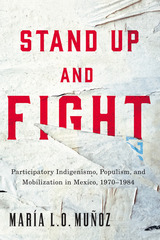 Stand Up and Fight: Participatory Indigenismo, Populism, and Mobilization in Mexico, 1970–1984
María L. O. Muñoz
University of Arizona Press, 2016 In 1975 a watershed moment captivated Mexico as indigenous peoples from across the country came together on the Island of Janitzio for the First National Congress of Indigenous Peoples. The congress was a federal government initiative intended to preempt an independent indigenous movement. But indigenous groups circumvented the intended containment policies of the congress and made bold demands for political self-determination.
Using previously unavailable documents, María L. O. Muñoz examines the events that led to the congress, the meeting itself, and developments after the assembly. Muñoz shows how indigenous leaders working within Mexico’s Department of Colonization and Agrarian Affairs (DAAC) sidestepped state attempts to control indigenous communities, and how they made bold demands that redefined the ways federal and state governments engaged with pueblos indígenas.
Through research in previously untapped archives, Muñoz is able to trace the political history of the indigenous leaders and government officials who redefined the ways indigenous peoples engaged with governments. She illustrates the fluid and evolving power relationships of the key players with a focus on the twelve years of populism in the last decades of the twentieth century.
This book challenges the discourse of unquestioned power and hegemony of the national ruling party, the Institutional Revolutionary Party (PRI), and it illustrates how indigenous communities in Mexico reimagined their roles in the social, political, and economic life of the nation.
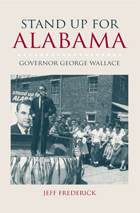 Stand Up for Alabama: Governor George Wallace
Jeffrey Frederick
University of Alabama Press, 2007 Whereas other studies have focused on George Wallace’s career as a national figure, Stand Up for Alabama provides a detailed, comprehensive, and analytical study of Wallace’s political life that emphasizes his activities and their impact within the state of Alabama. Jeff Frederick answers two fundamental questions: What was George Wallace’s impact on the state of Alabama? Why did Alabamians continue to embrace him over a twenty-five year period? Using a variety of sources to document the state’s performance in areas including mental health, education, conservation, prisons, and industrial development, Frederick answers question number one. He cites comparisons between Alabama and both peer states in the South and national averages. Wallace’s policies improved the state, but only in relation to Alabama’s past, not in relation to peer states in the region or national averages. As a result, energy was expended but little progress was made. To answer the second question, Frederick uses the words of Alabamians themselves through oral history, correspondence, letters to the editor, and other sources. Alabamians, white and eventually black, supported Wallace because race was but one of his appeals. Stand Up for Alabama shows that Wallace connected to Alabamians at a gut level, reminding them of their history and memory, championing their causes on the stump, and soothing their concerns about their place in the region and the nation. Jeff Frederick examines the development of policy during the Wallace administrations and documents relationships with his constituents in ways that go beyond racial politics. He also analyzes the connections between Wallace’s career and Alabamians’ understanding of their history, sense of morality, and class system. “Stand up for Alabama” was the governor’s campaign slogan.
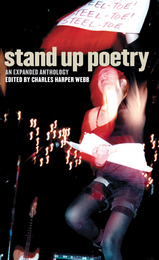 Stand Up Poetry: An Expanded Anthology
Charles Harper Webb
University of Iowa Press, 2002 Contributors: Kim Addonizio
Dorothy Barresi
Charles Bukowski
Maxine Chernoff
Lucille Clifton
Billy Collins
Philip Dacey
Stephen Dunn
Deborah Harding
Edward Hirsch
Tony Hoagland
Allison Joseph
Jesse Lee Kercheval
Lisa Lewis
Bill Mohr
Ed Ochester
Lawrence Raab
Maureen Seaton
James Tate
Rafael Zepeda
plus many more Witty, sexy, gritty, outrageous, emotional, hilarious, honest, courageous. What do these words describe? A growing movement in American literary circles: Stand Up Poetry. Over twenty years ago, Charles Harper Webb discovered a vibrant and invigorating poetry scene in southern California. Featuring some of America's best contemporary poets, this scene, according to Webb, “showed insight, imagination, craft, philosophical depth, but most of all, it was funny, and it was fun.” Stand Up Poetry: The Poetry of Los Angeles and Beyond (1990) was the result of Webb's enthusiasm for this poetic genre. A decade later, the popularity of performance poetry, poetry slams, and poetry readings is on the rise, and Webb has expanded his anthology to include a greater sampling of poets from across the country. From Charles Bukowski to Billy Collins and Allison Joseph, the poets included in this collection are popular and emerging, classical and experimental, young and old; yet all exhibit the characteristics so important to Stand Up Poetry—humor, performability, accessibility, individuality. Most important, these poems are enjoyable when read silently or aloud, on the page or on the stage. Stand Up Poetry: An Expanded Anthology is at its core a celebration of poetry offering readers a wonderful lesson in the power of words to entertain and inspire.
|
|
